
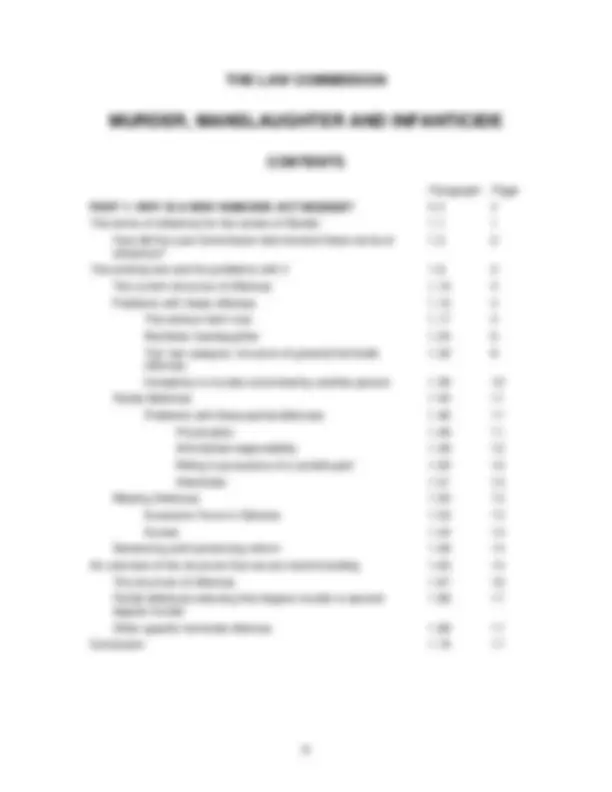
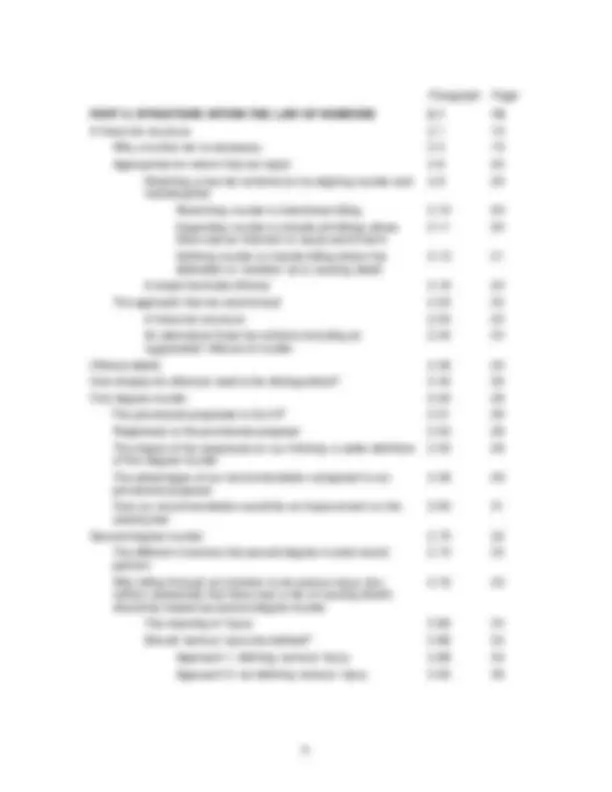
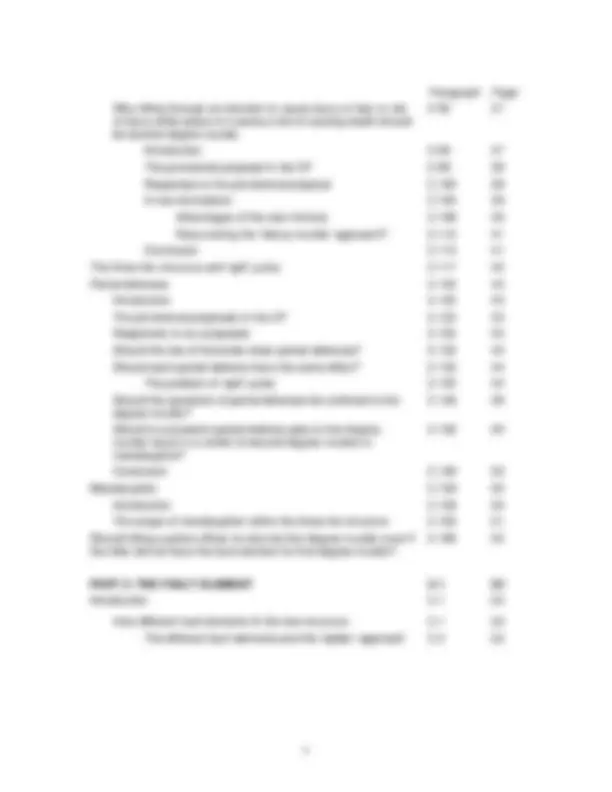
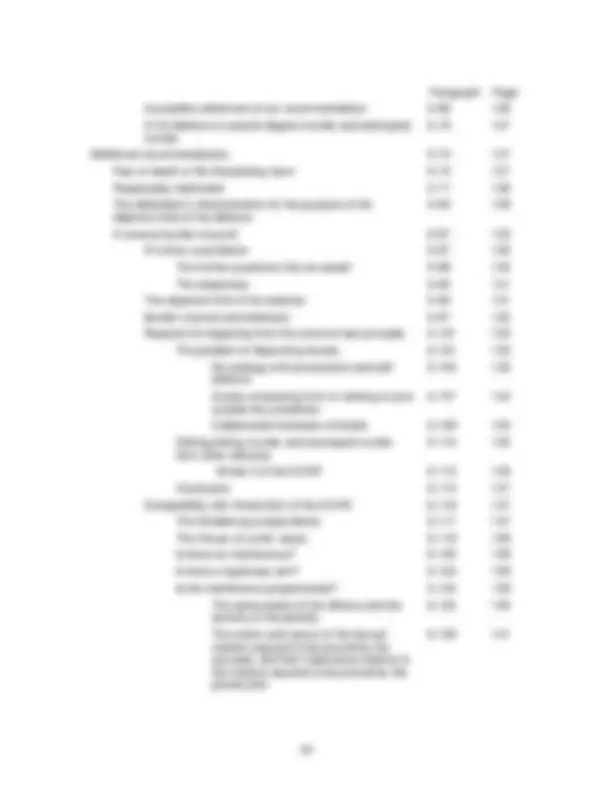
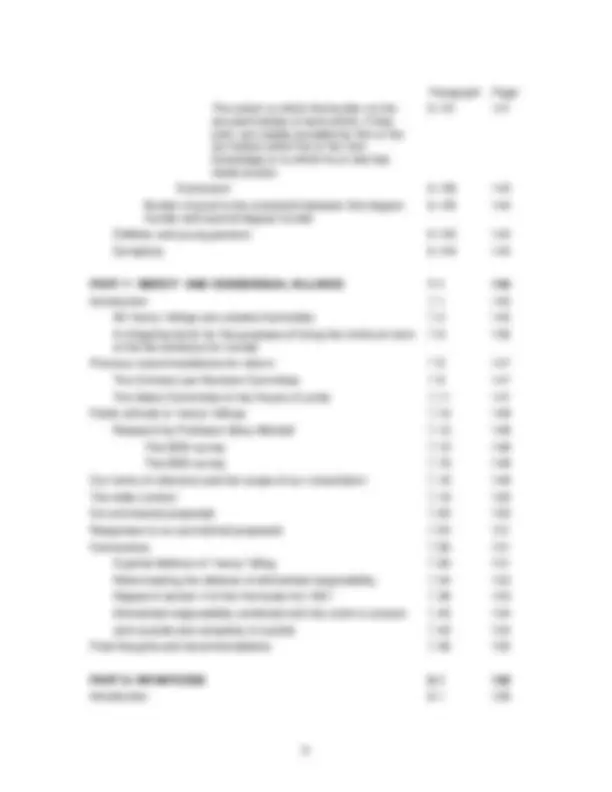
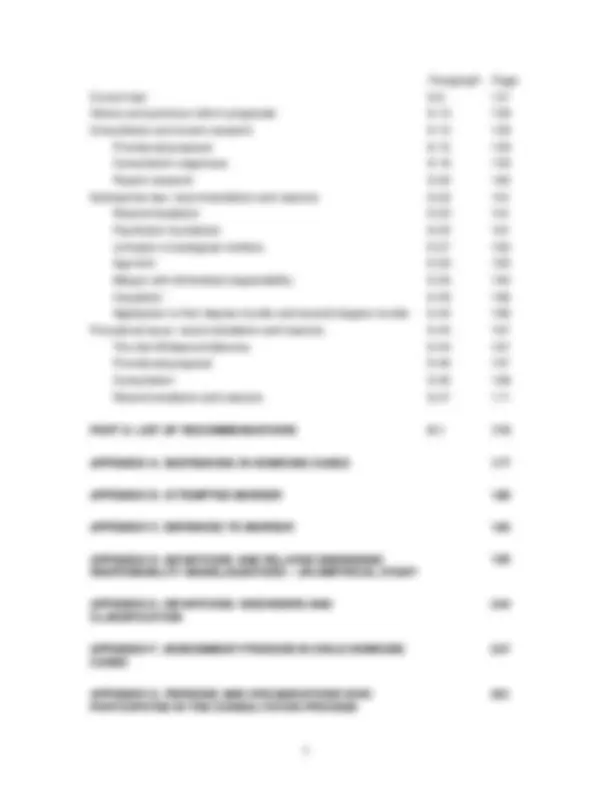
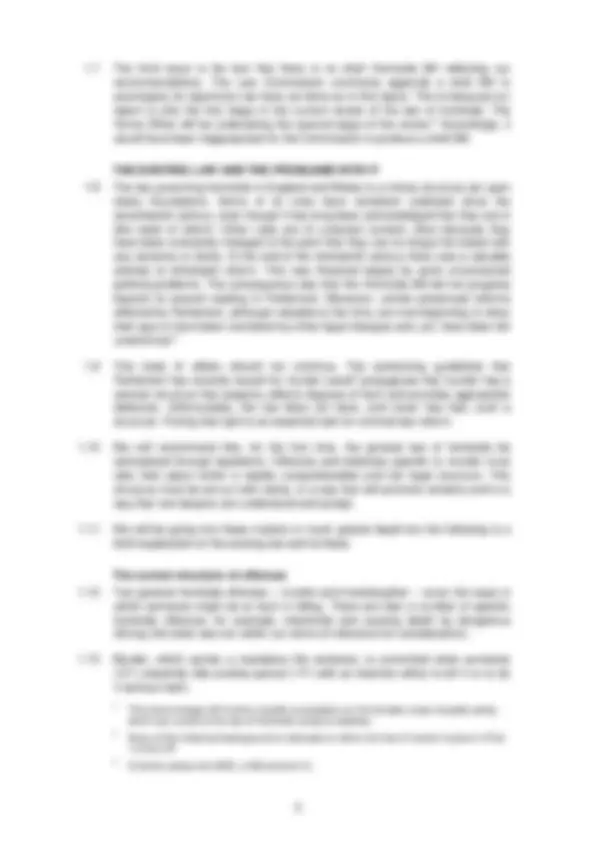
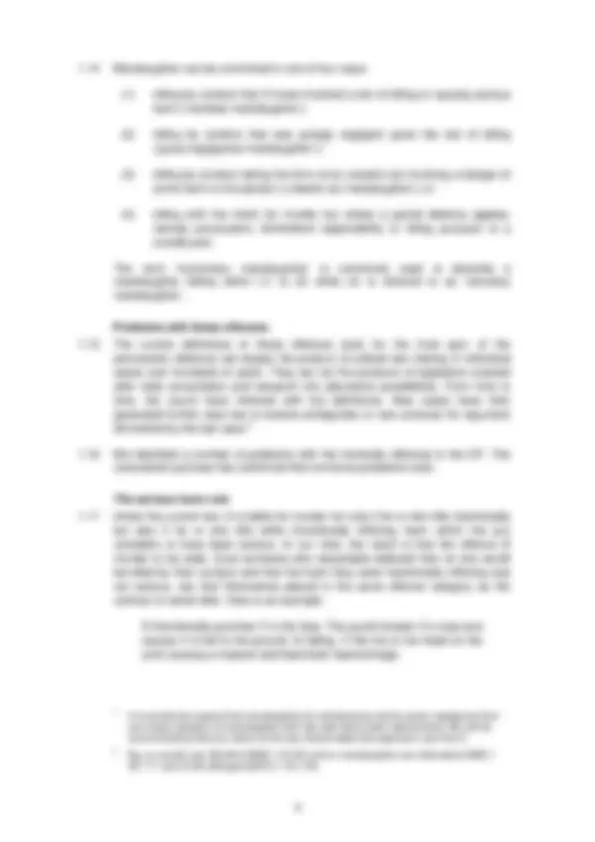
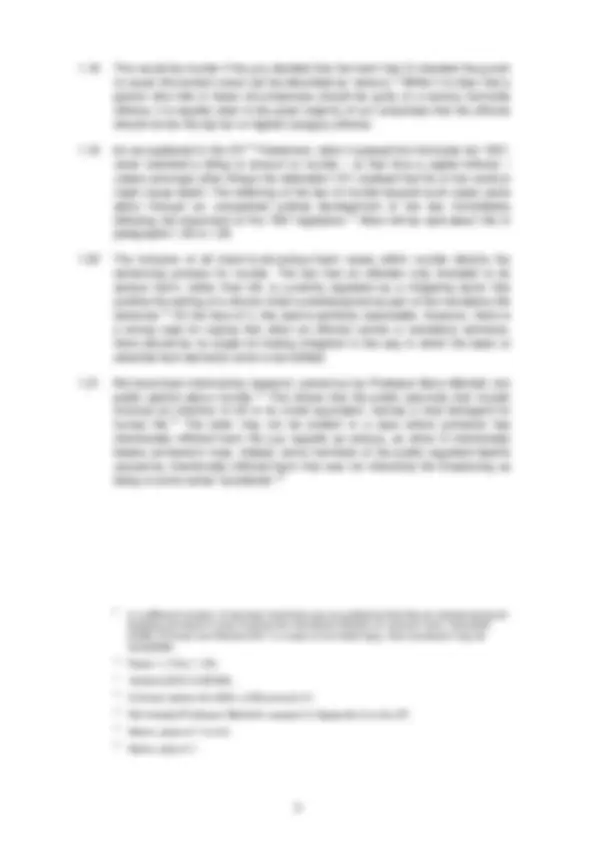
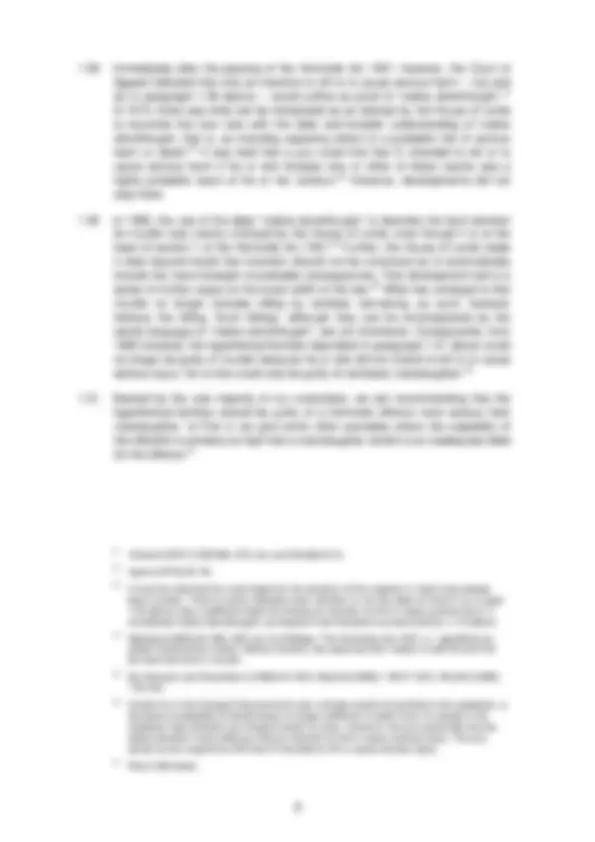
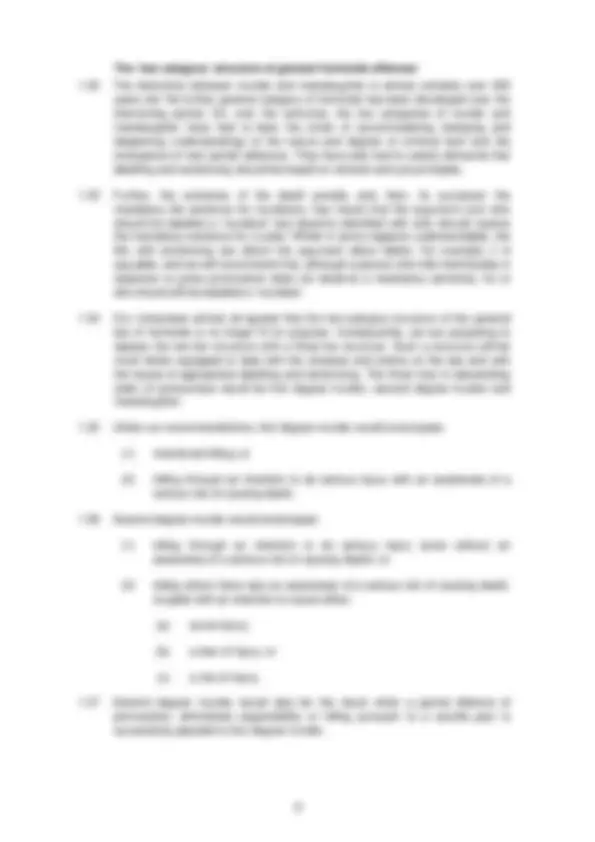
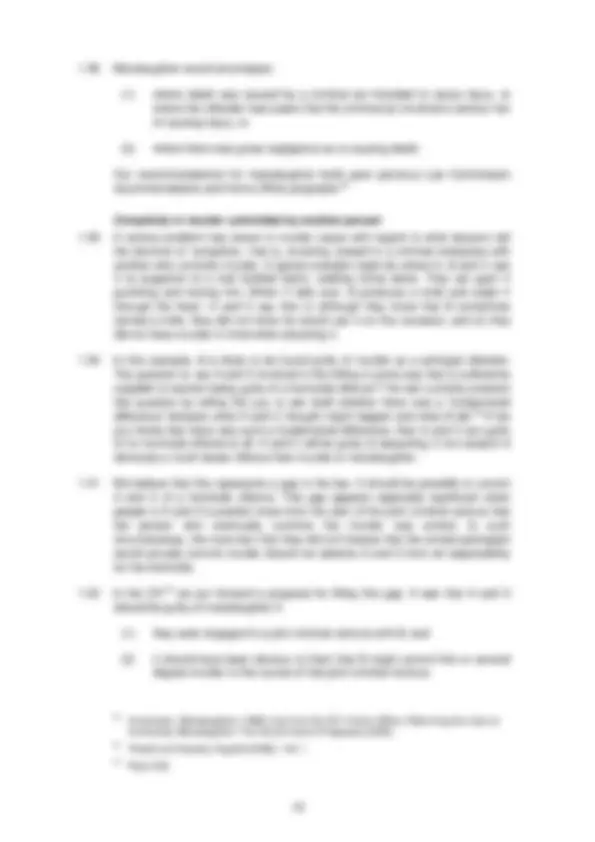
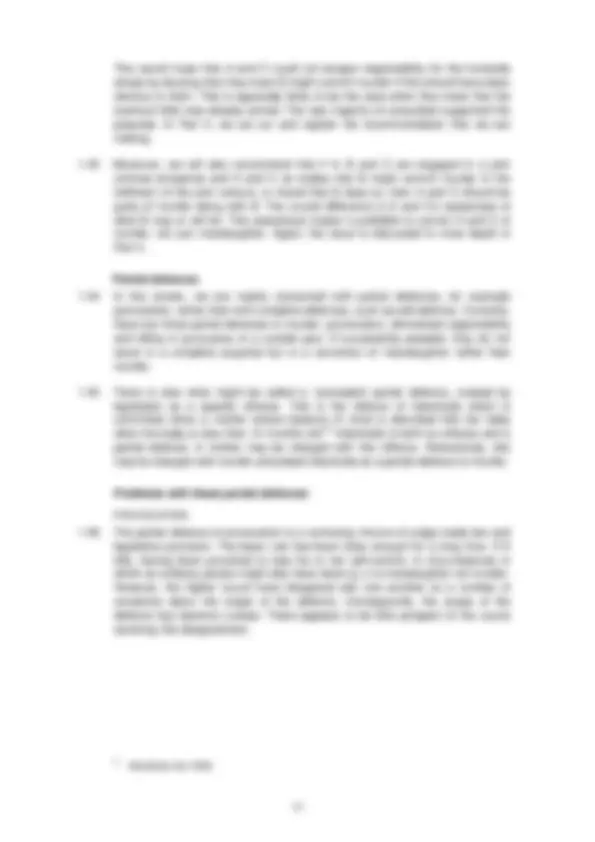
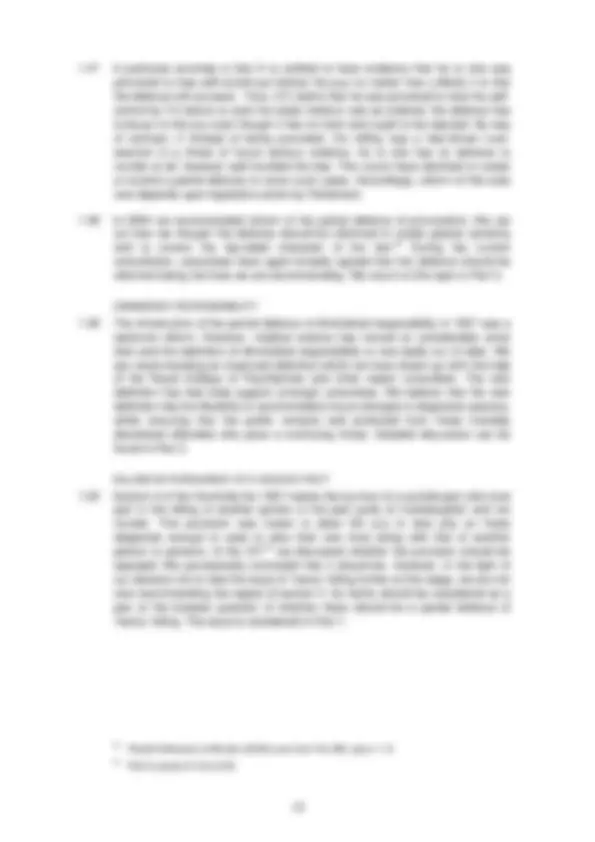


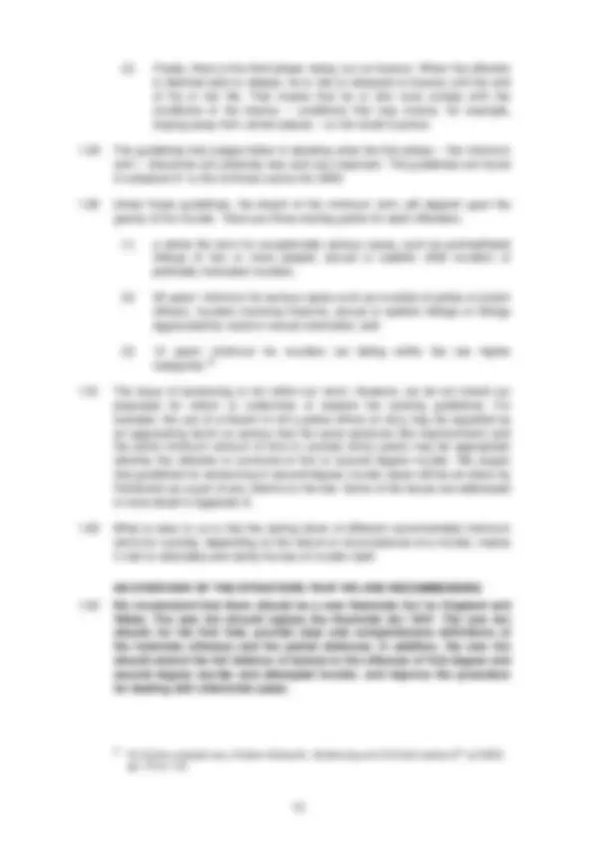
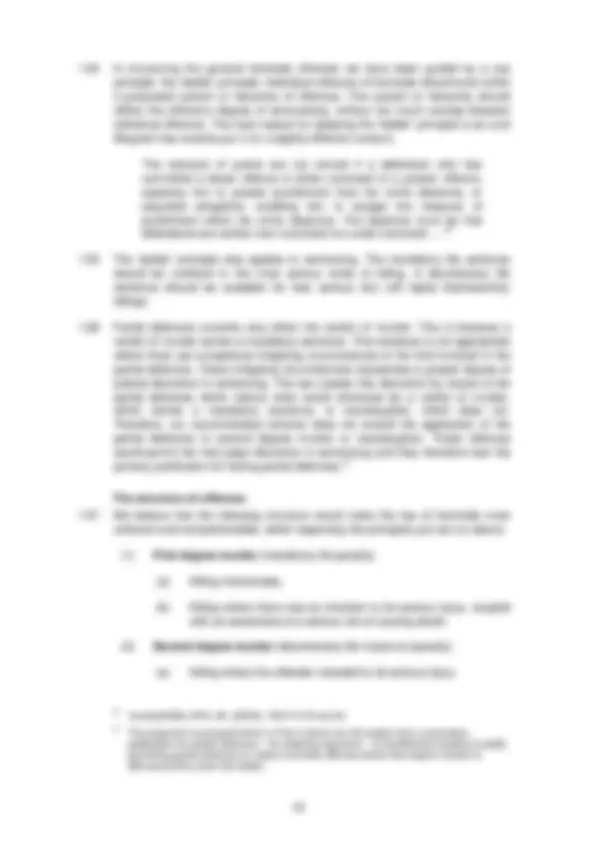
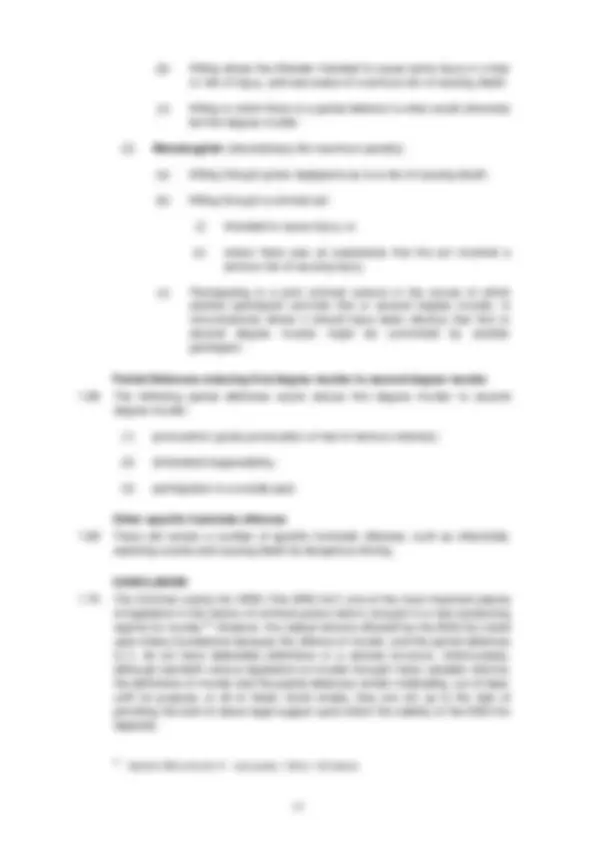

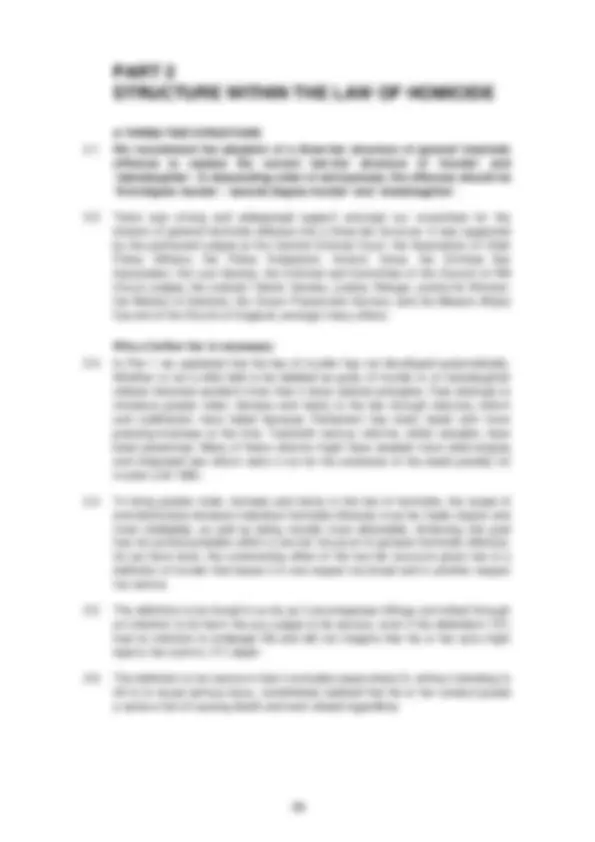
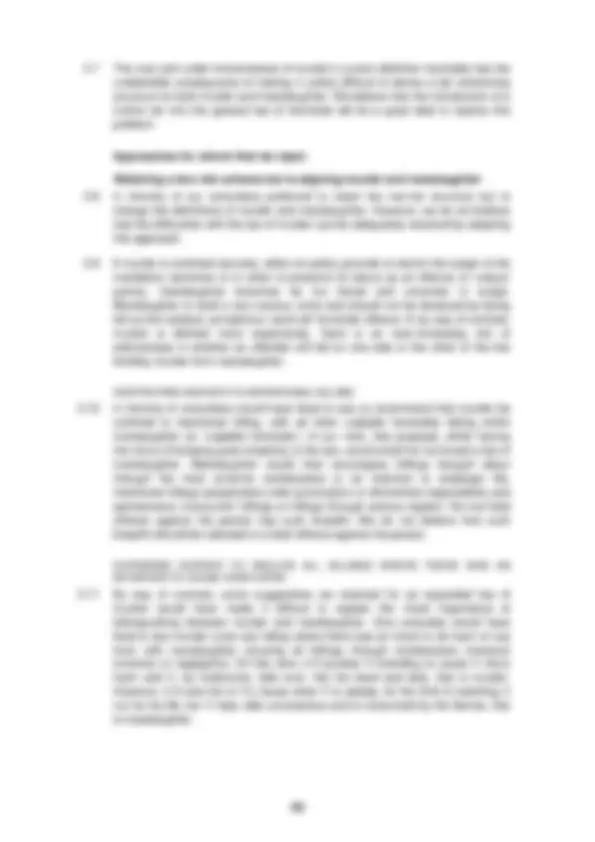
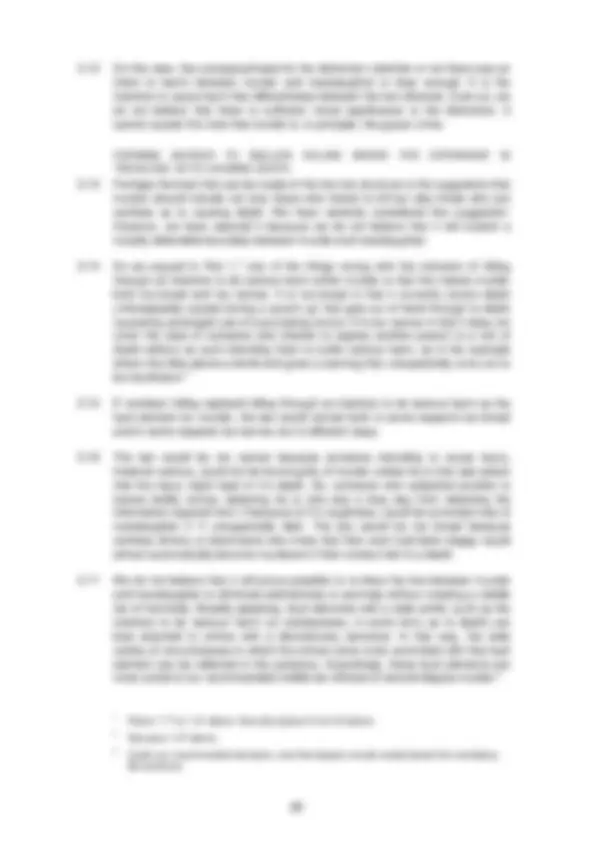
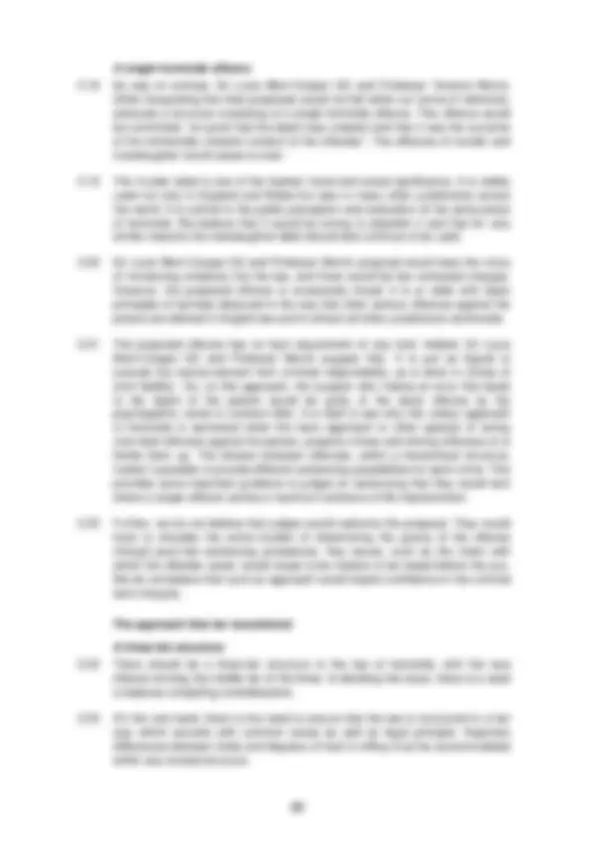
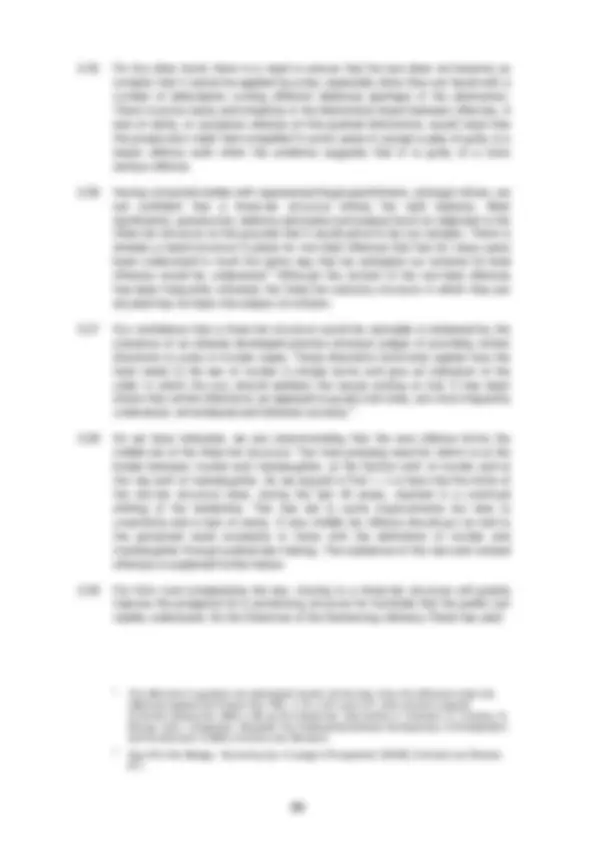
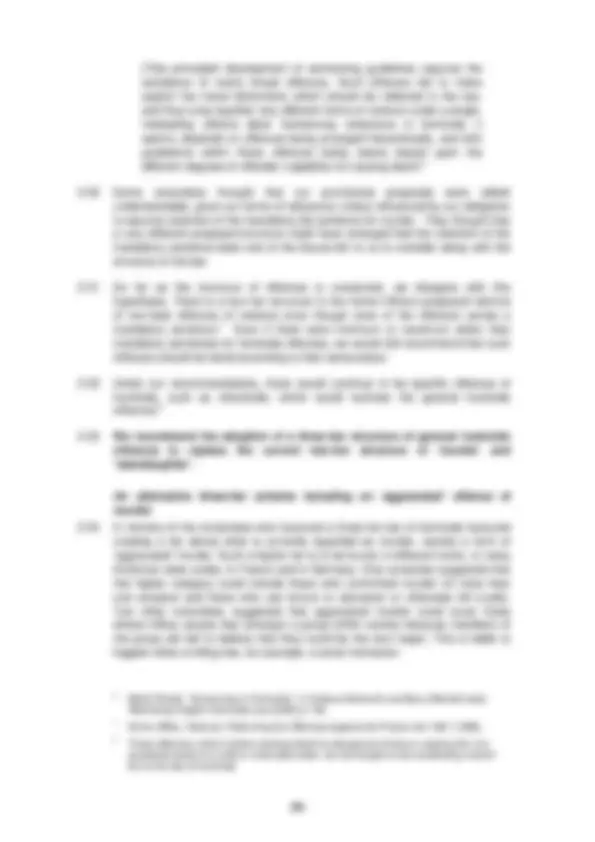
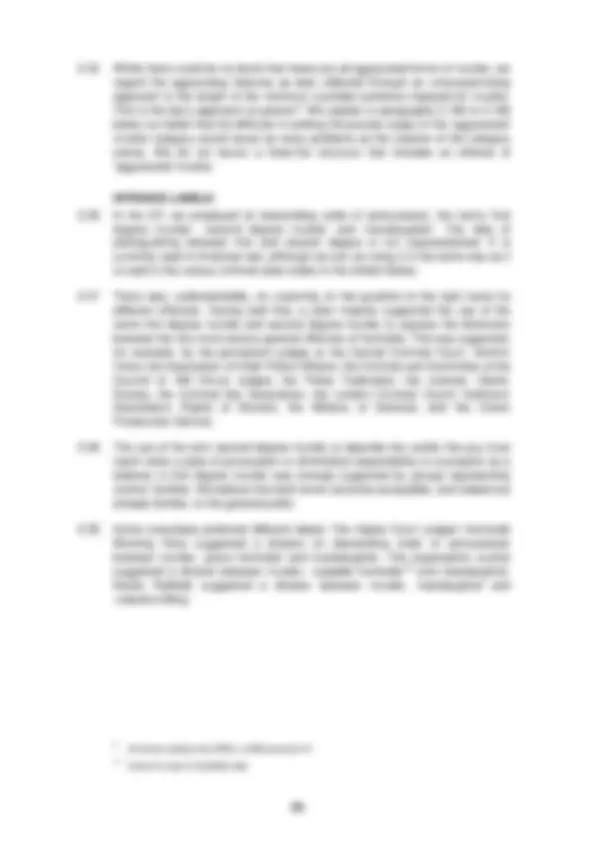
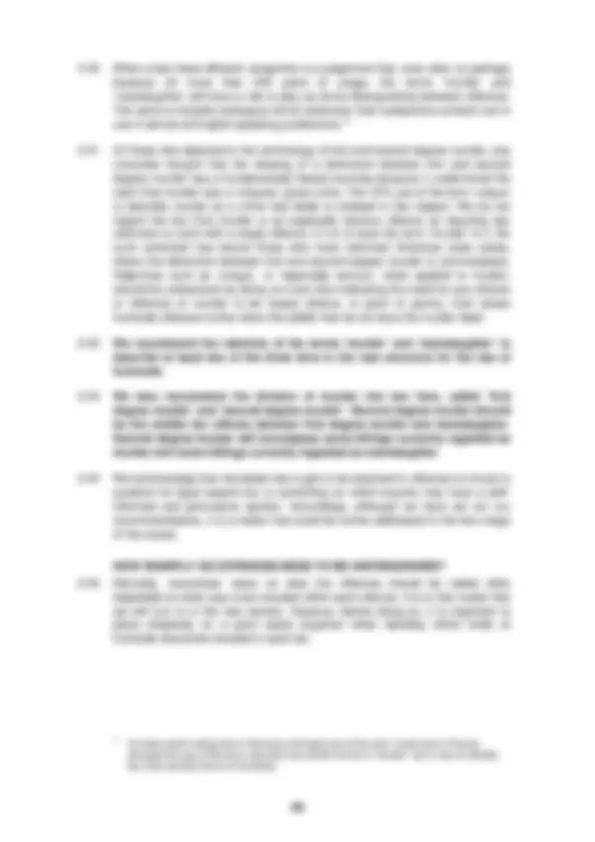
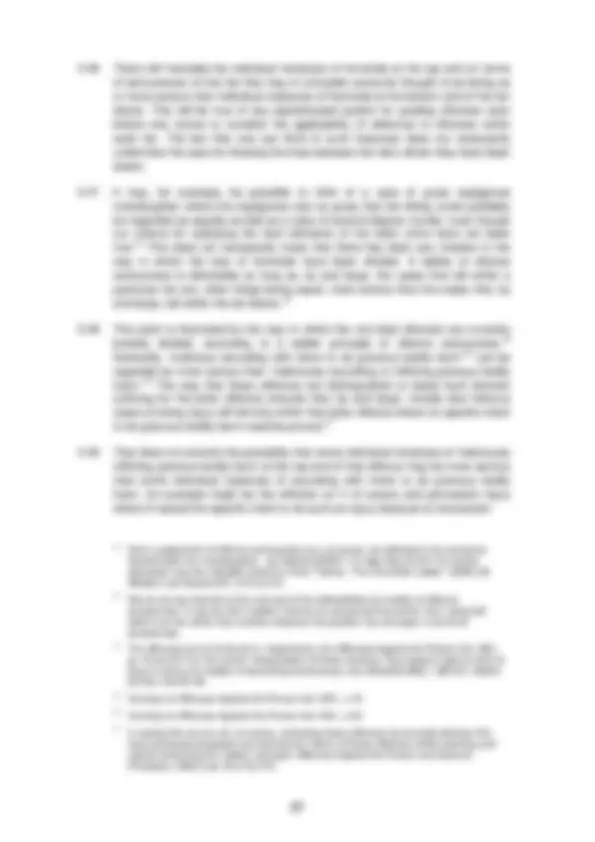
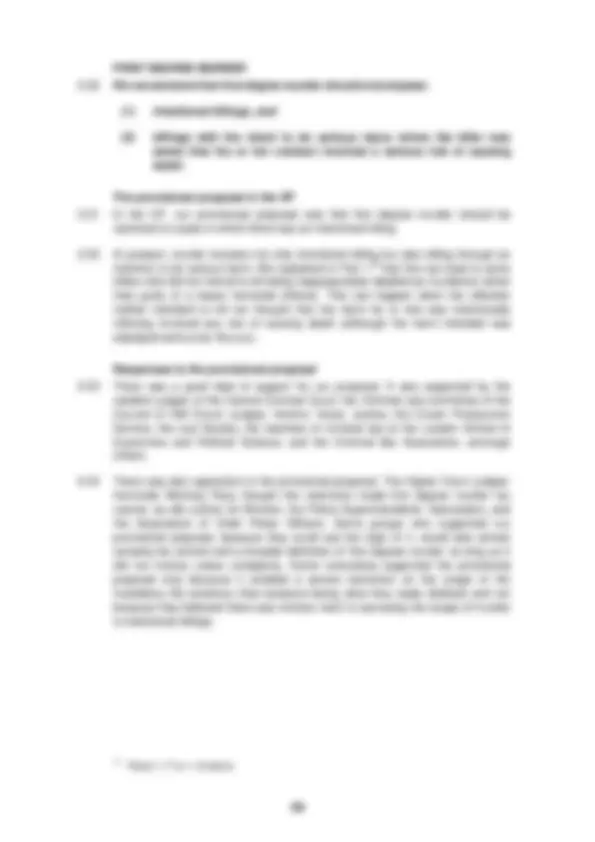
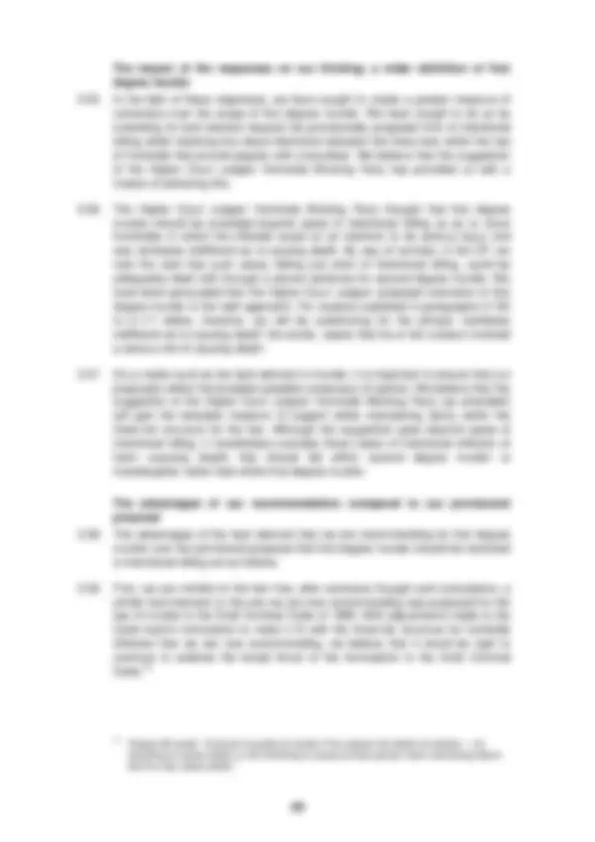
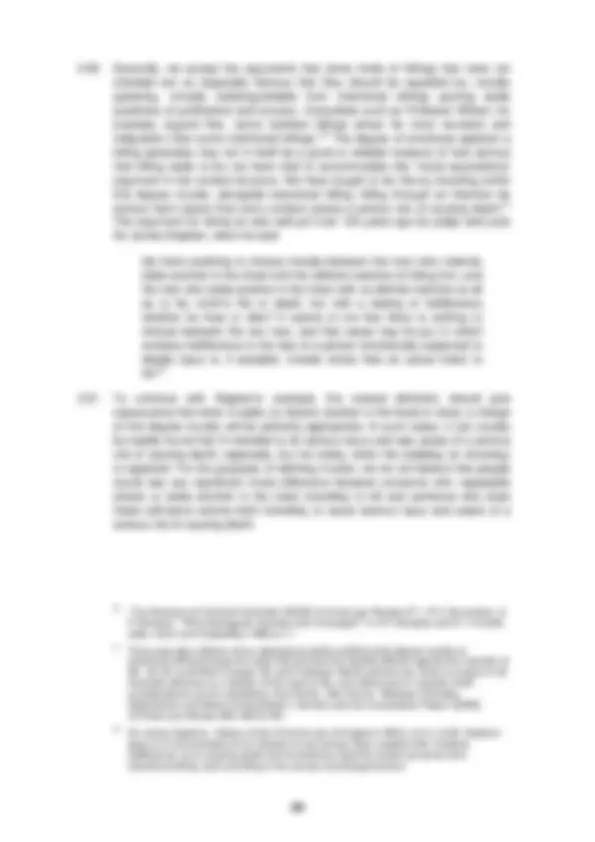
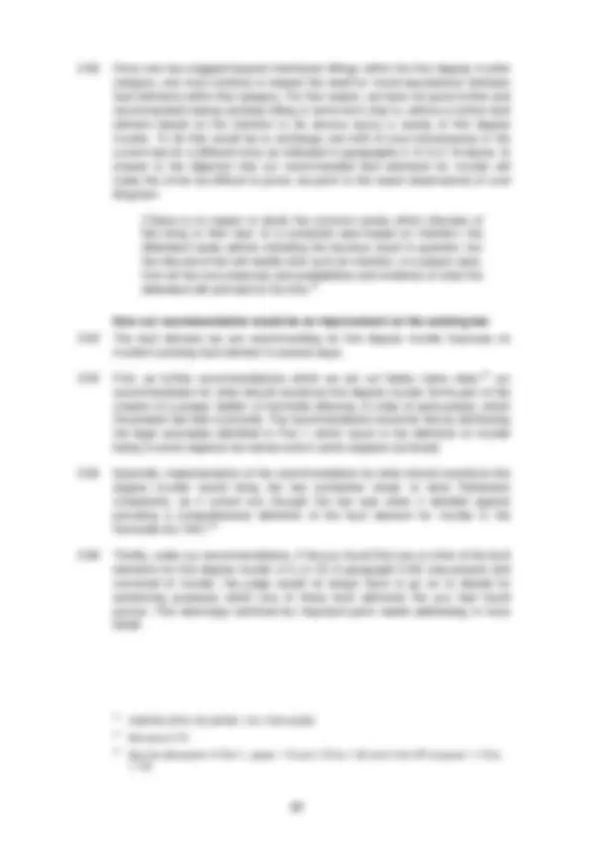
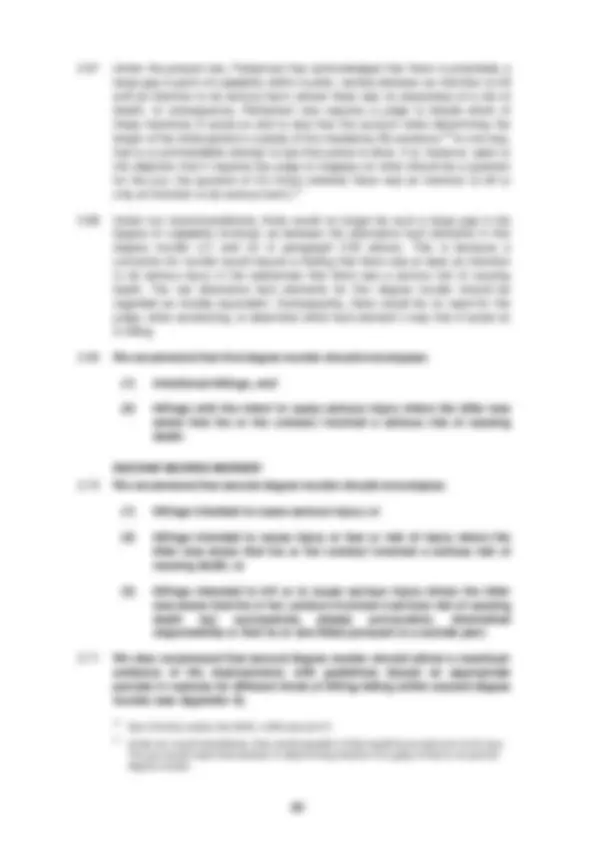
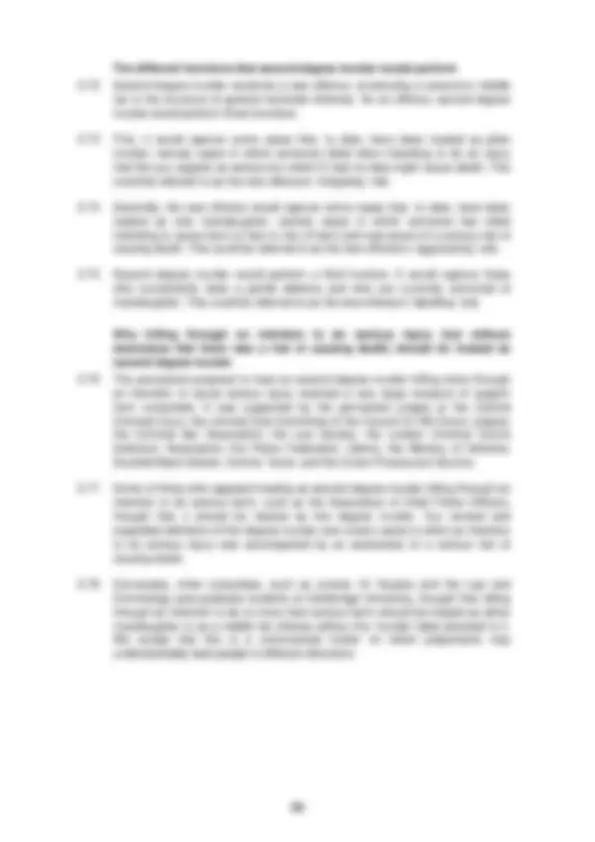
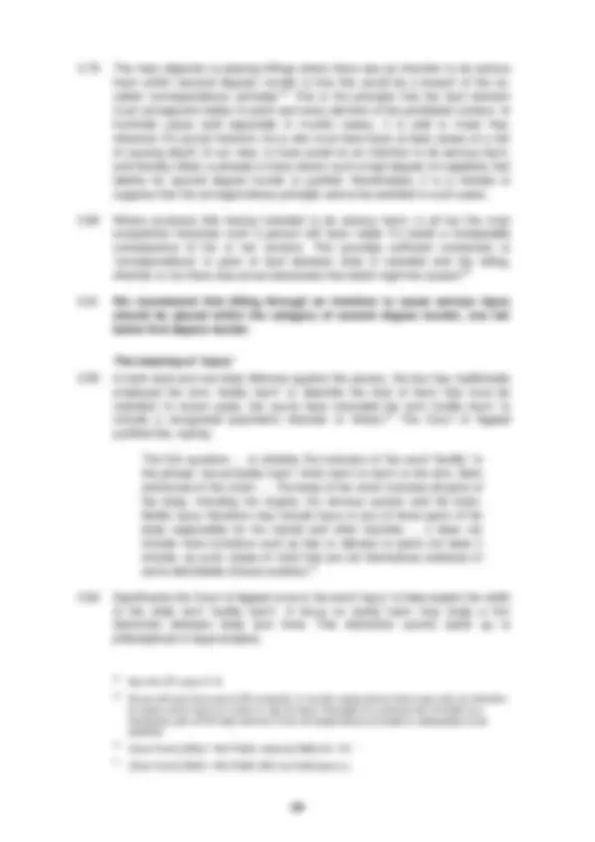
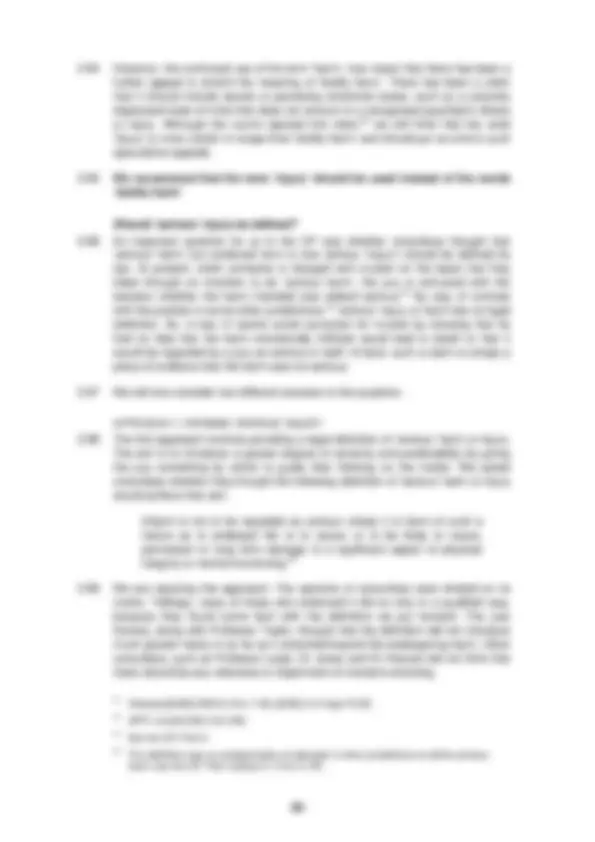
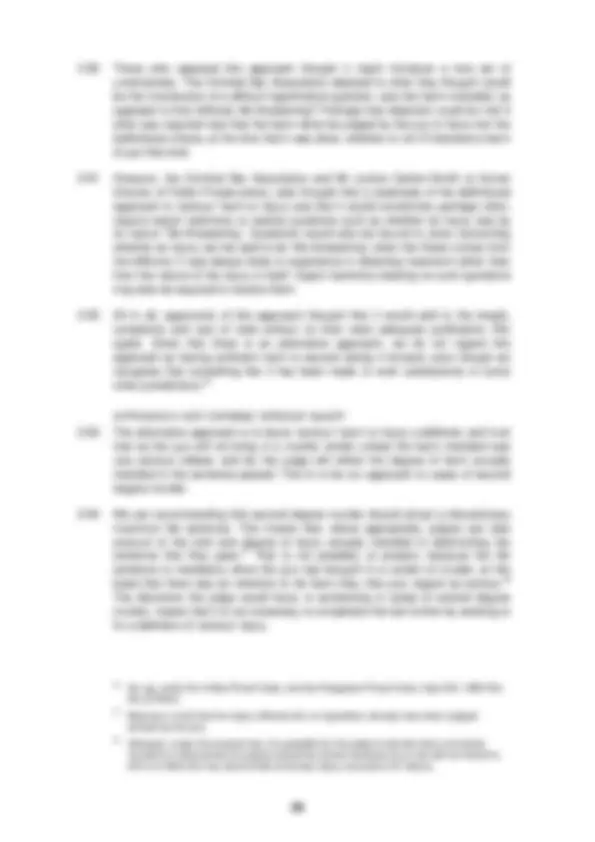
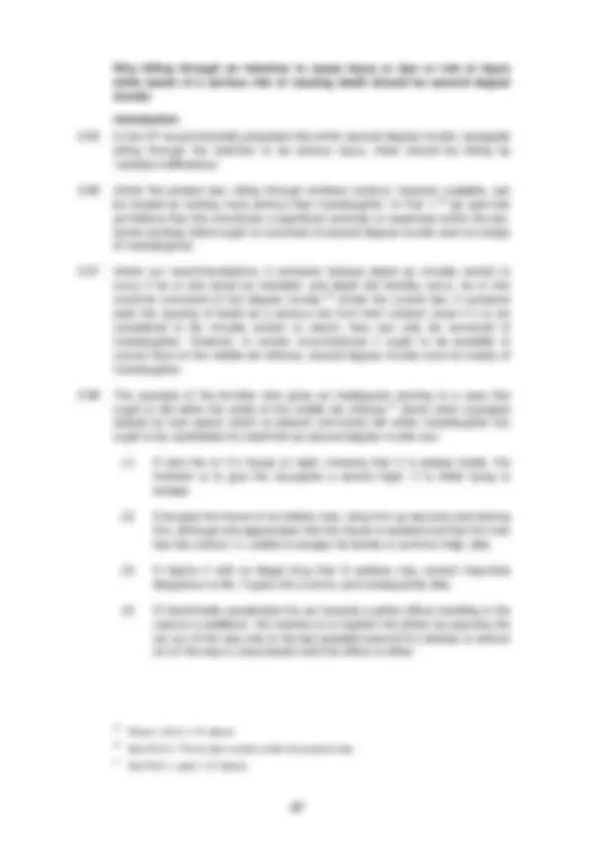
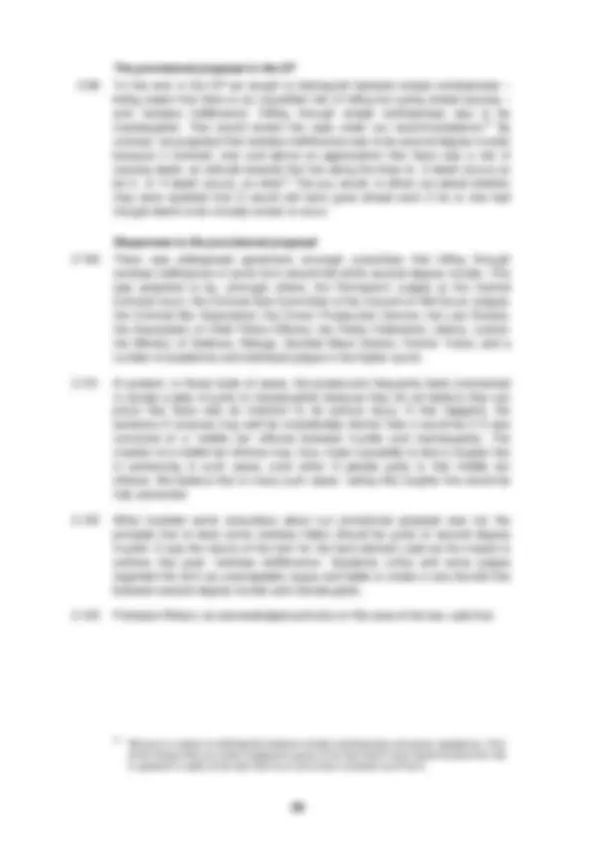
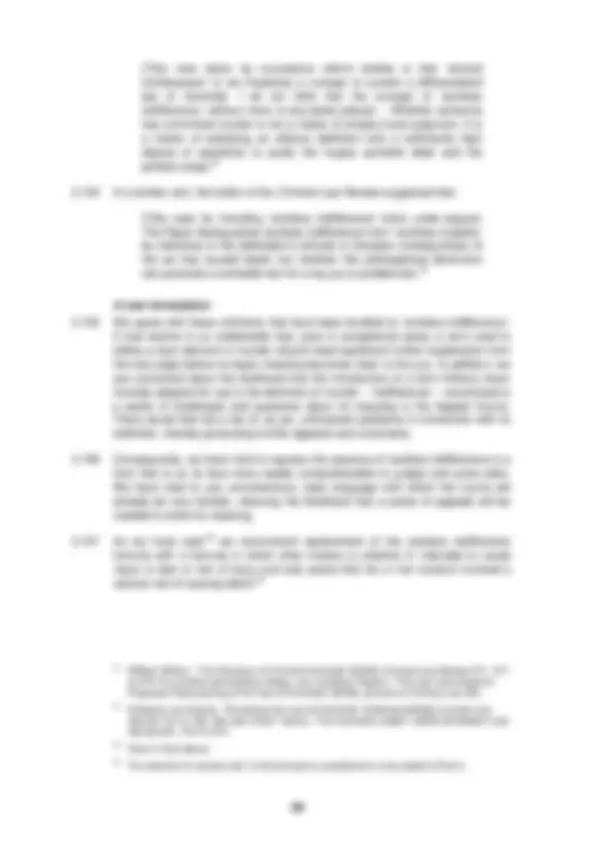
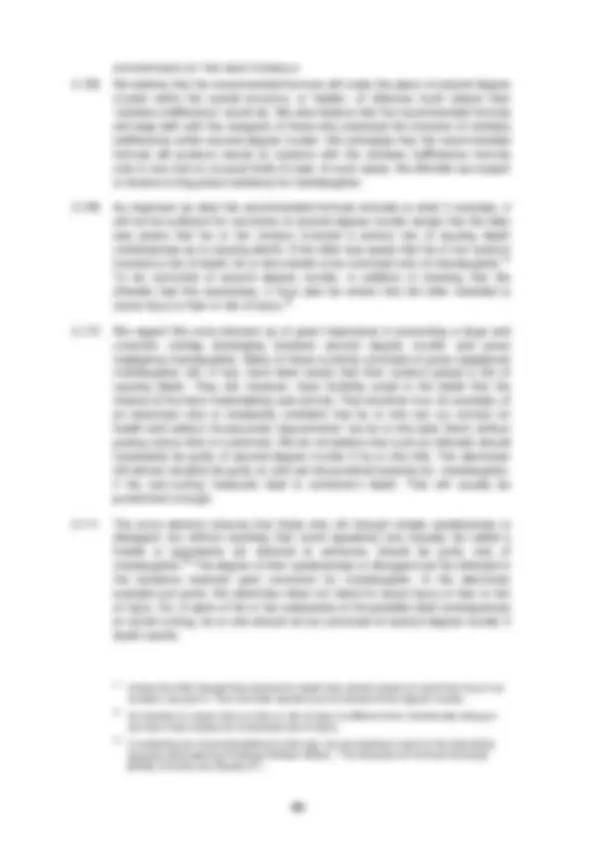
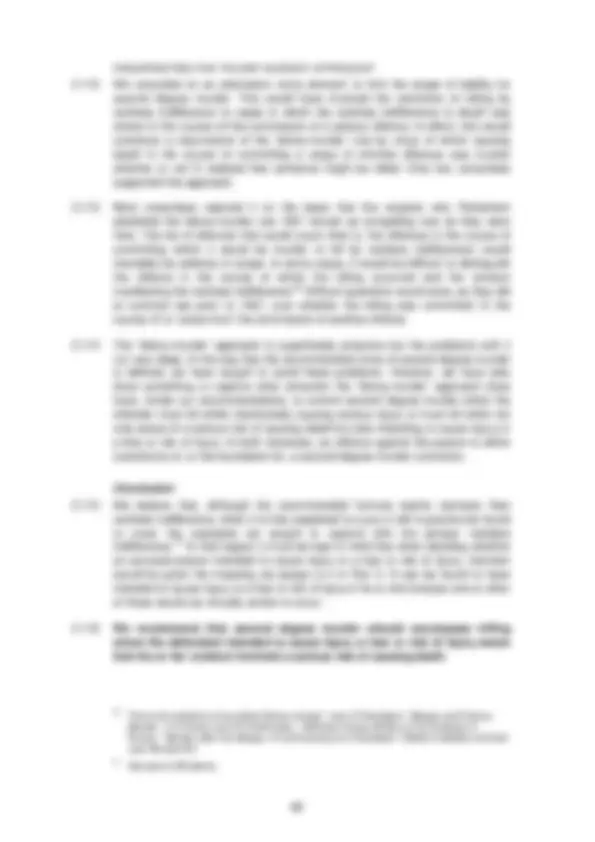
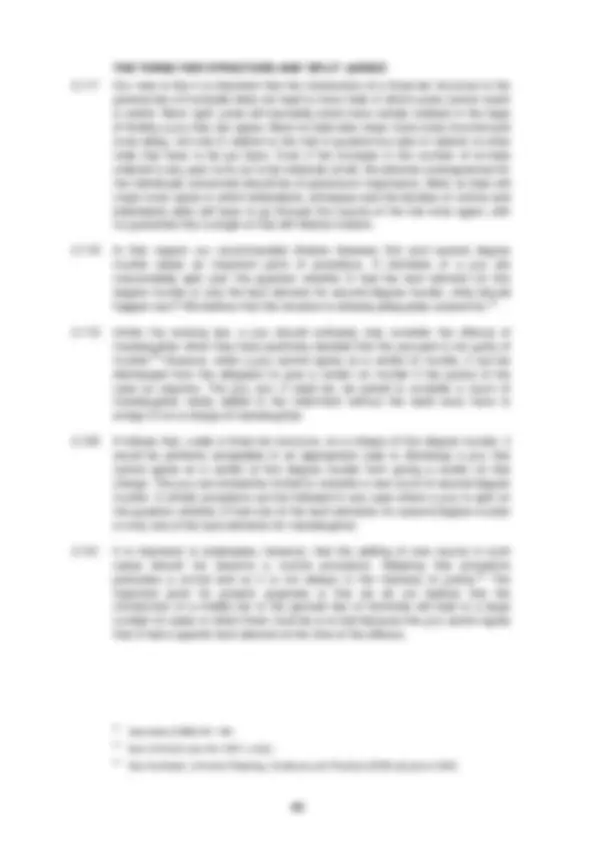
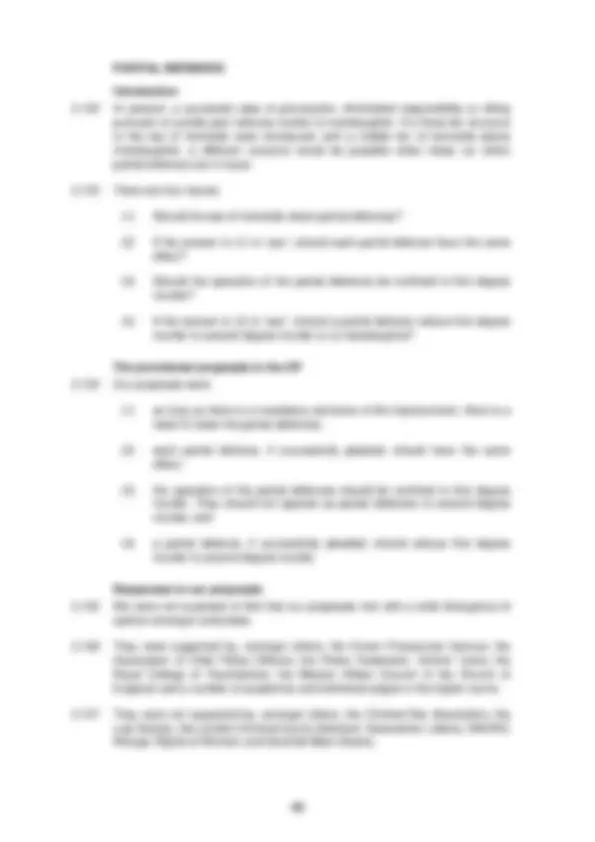
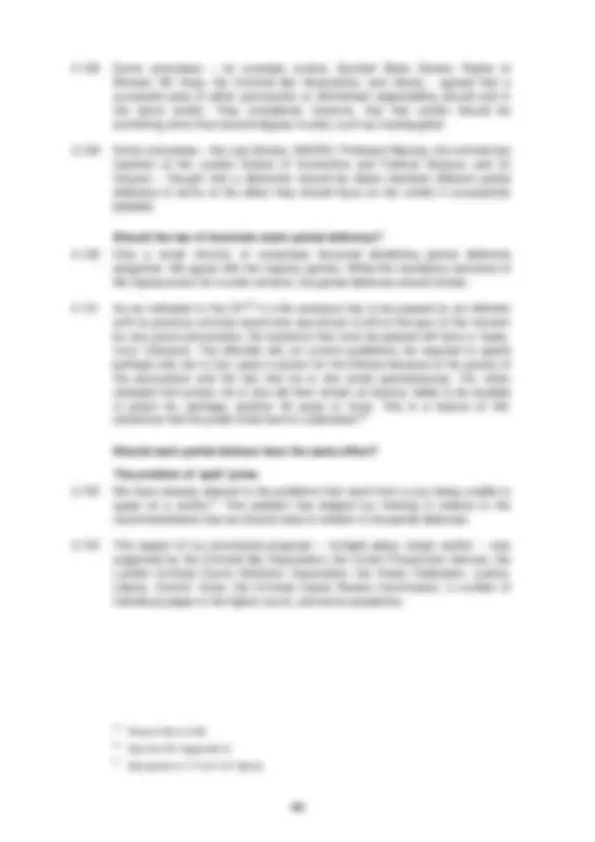
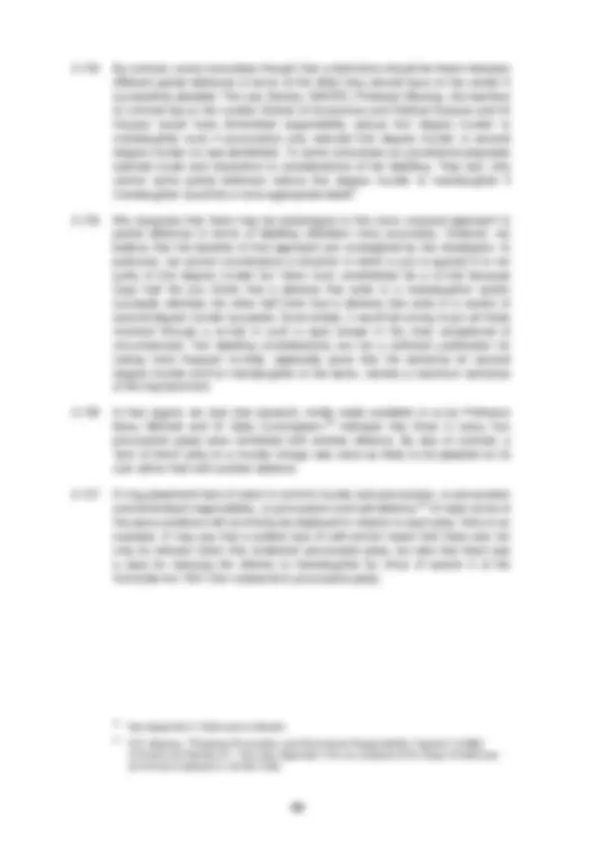
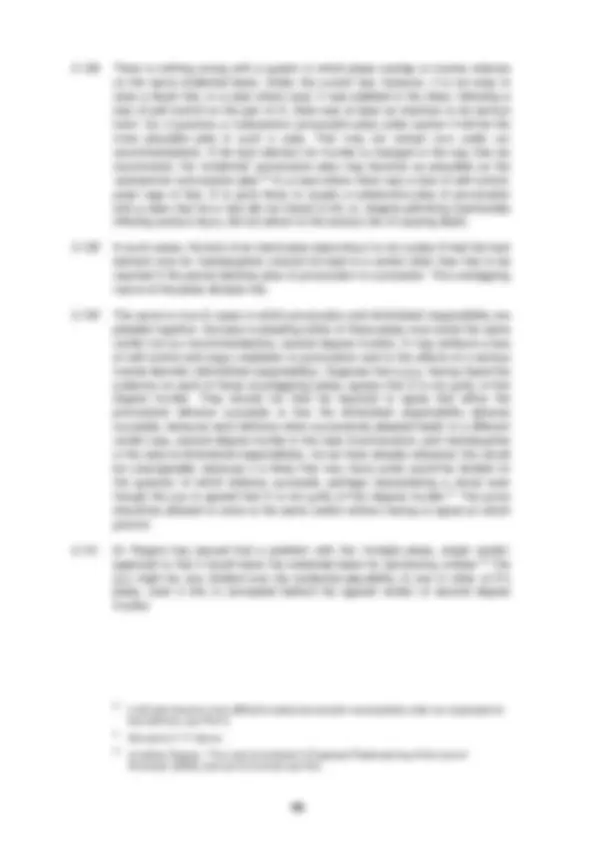
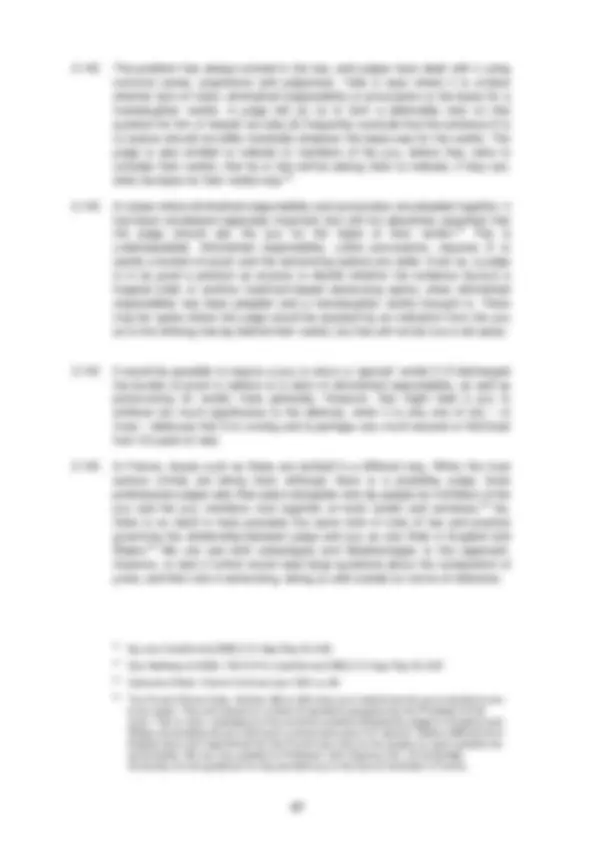
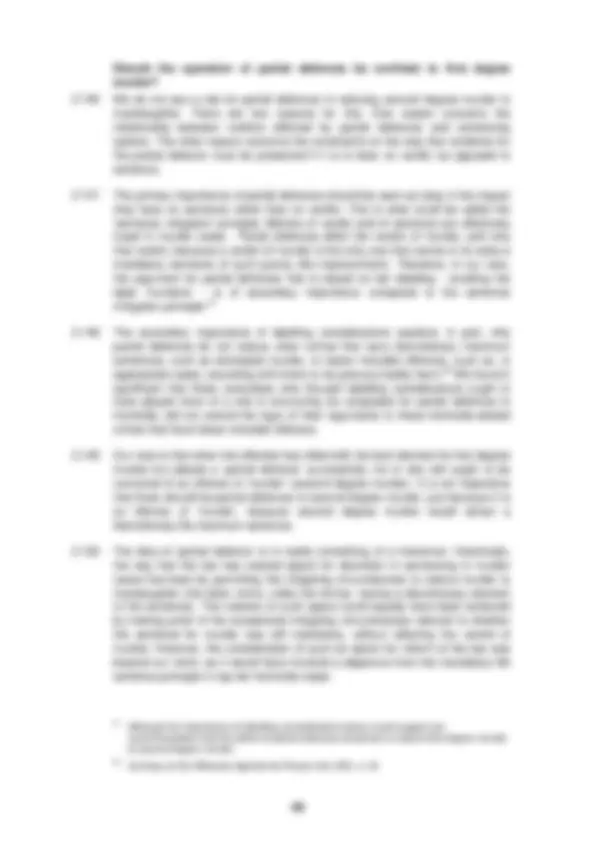
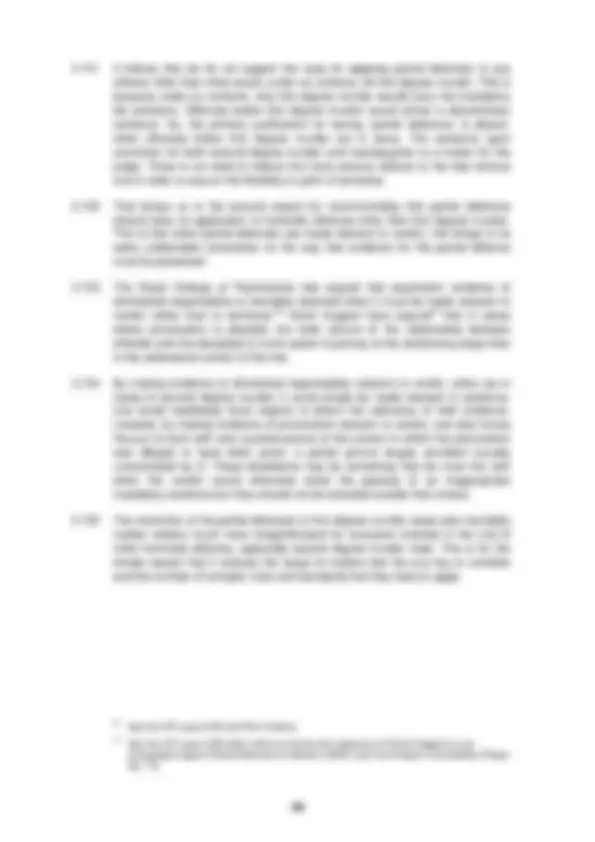
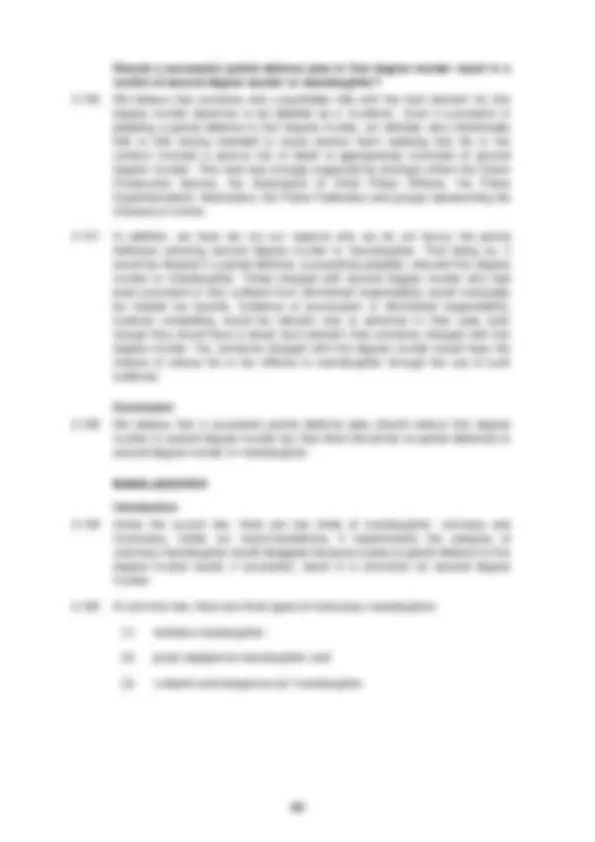
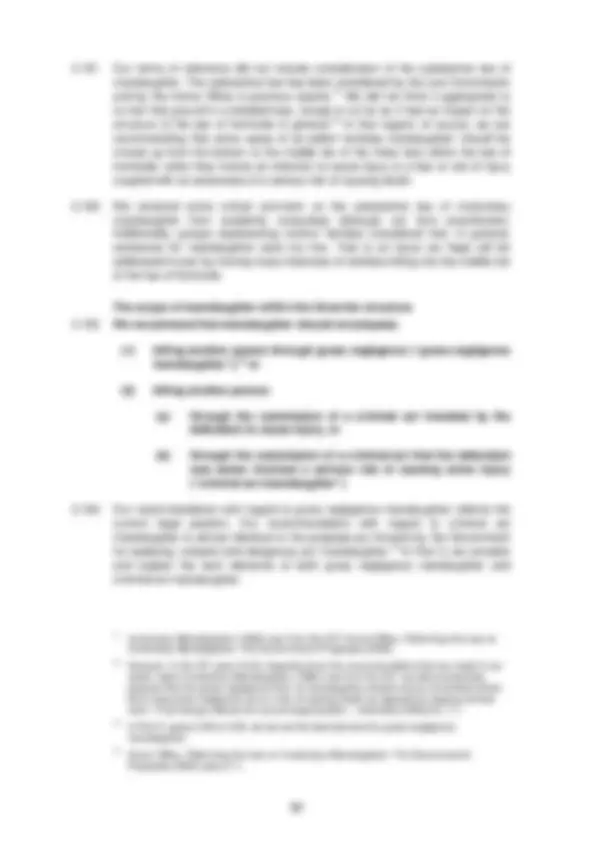
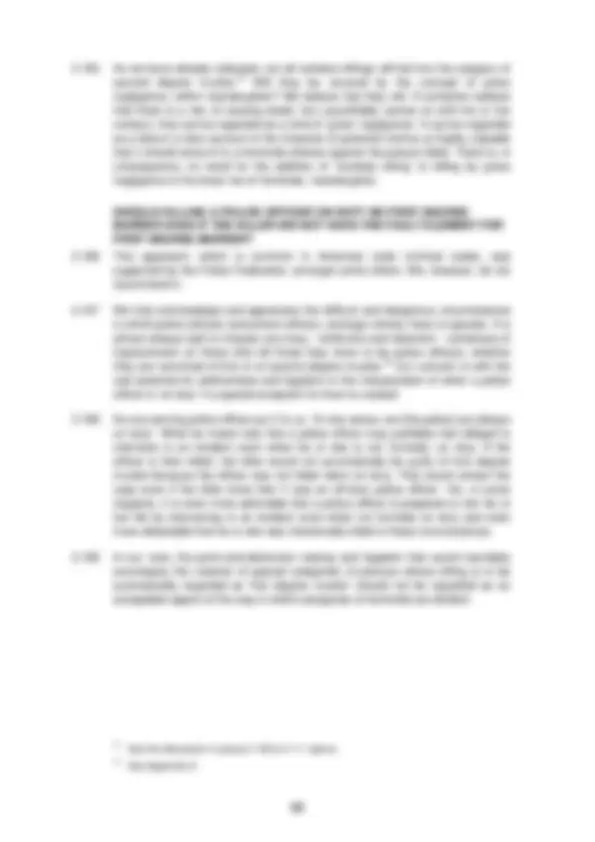
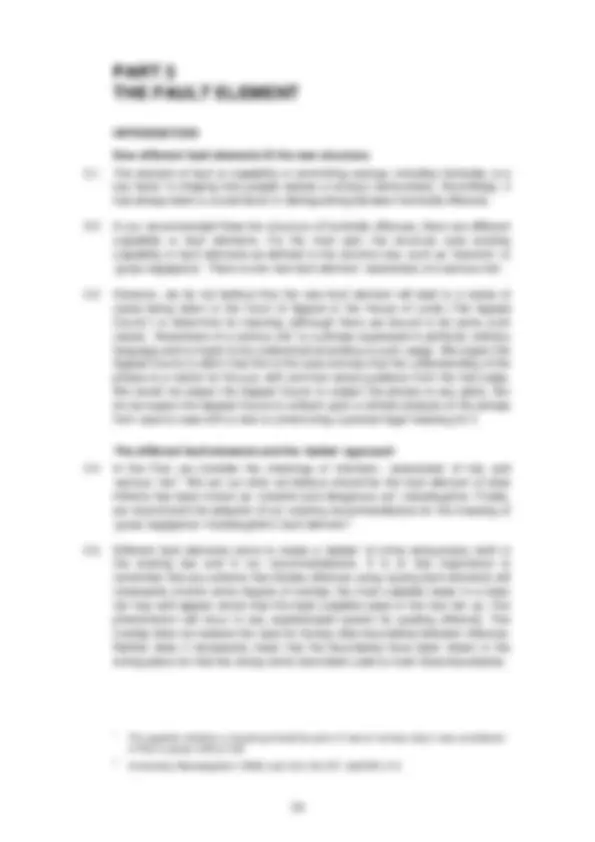
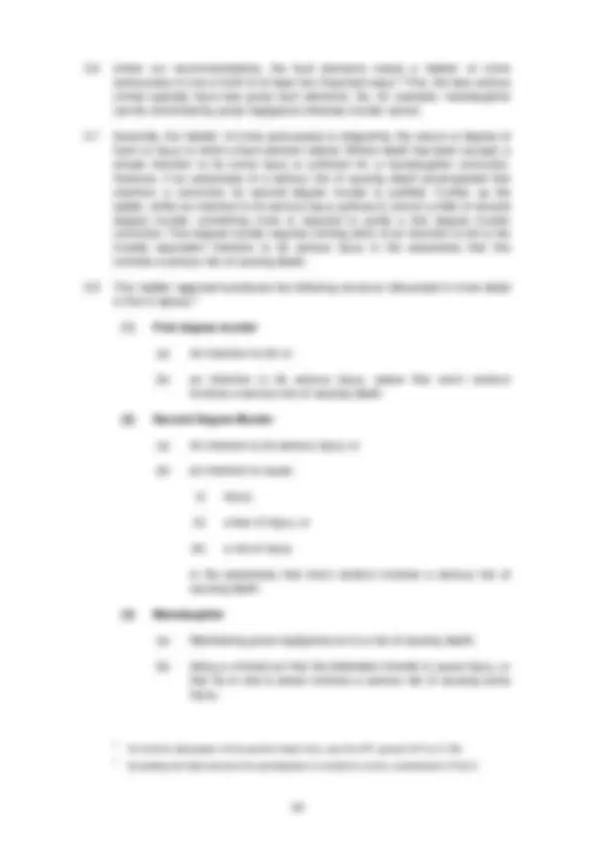
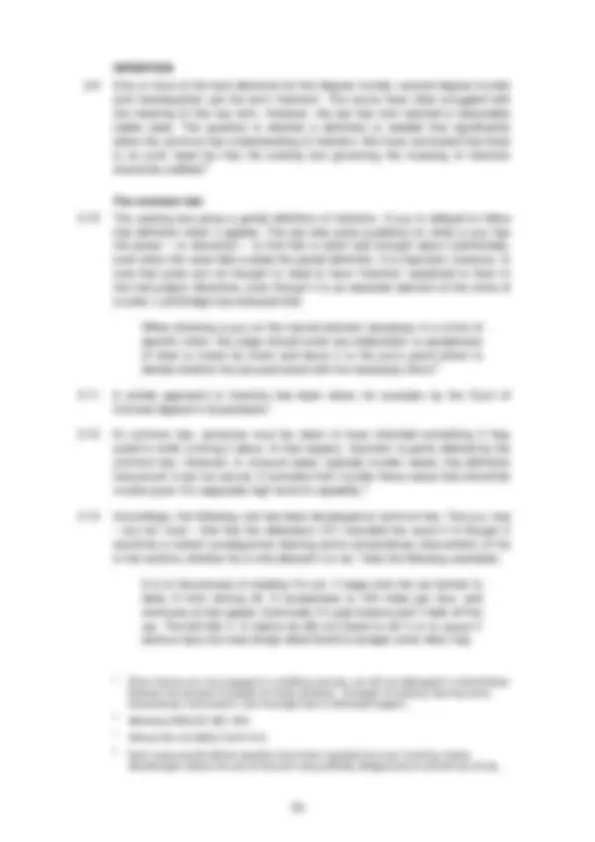
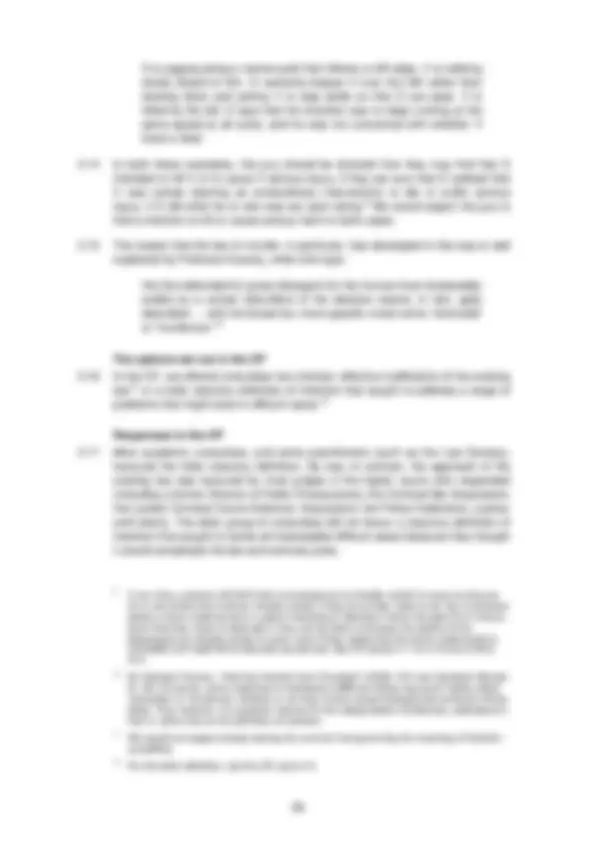
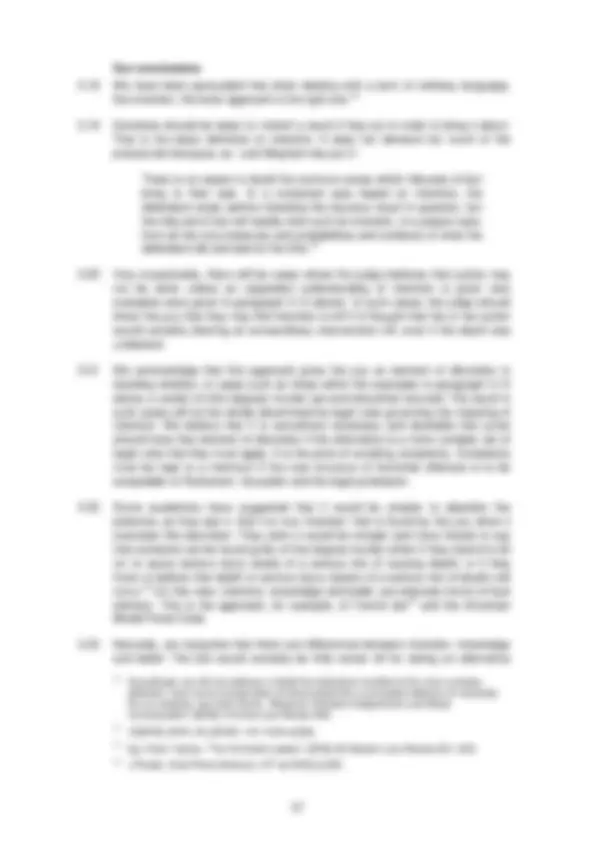
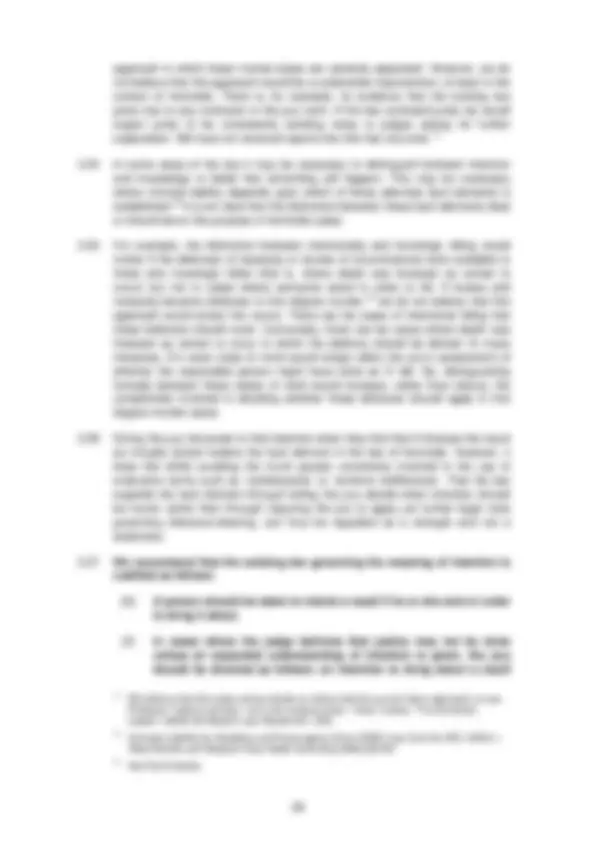
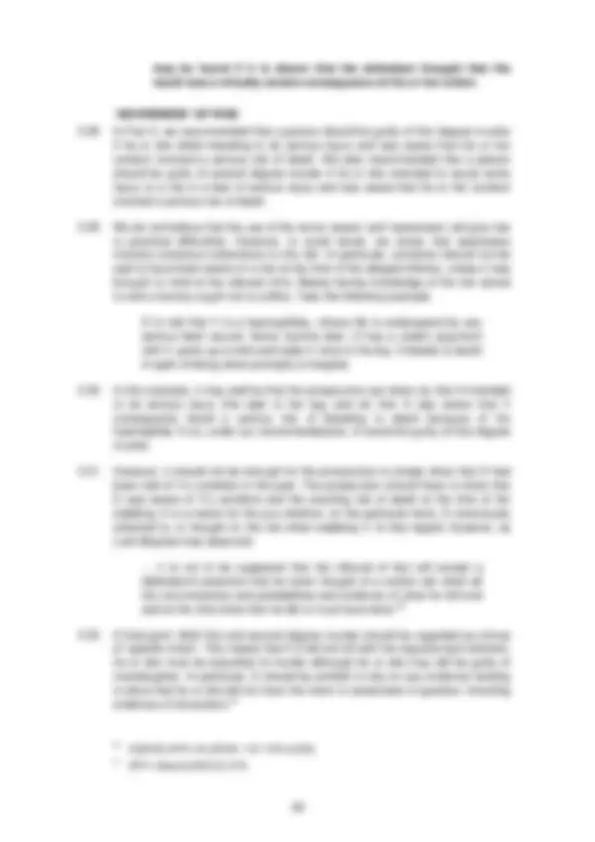
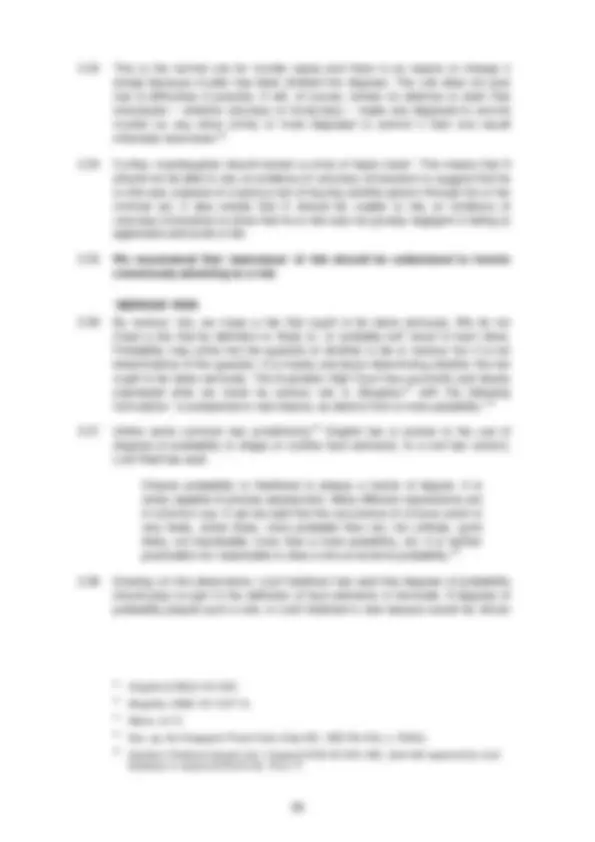
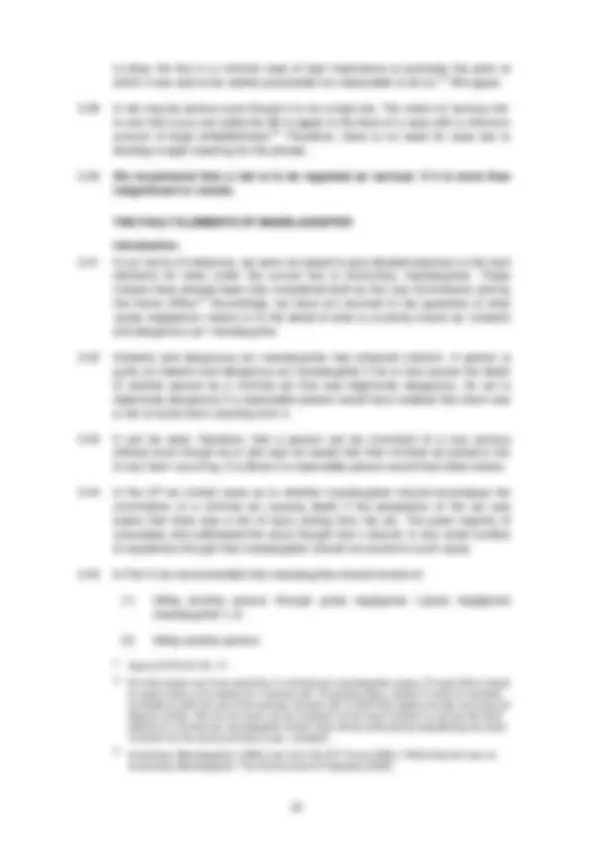
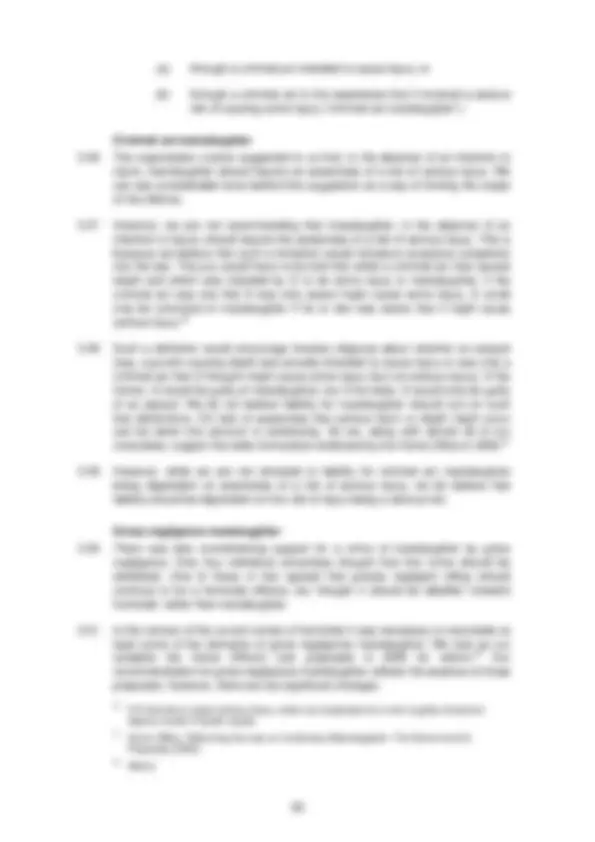
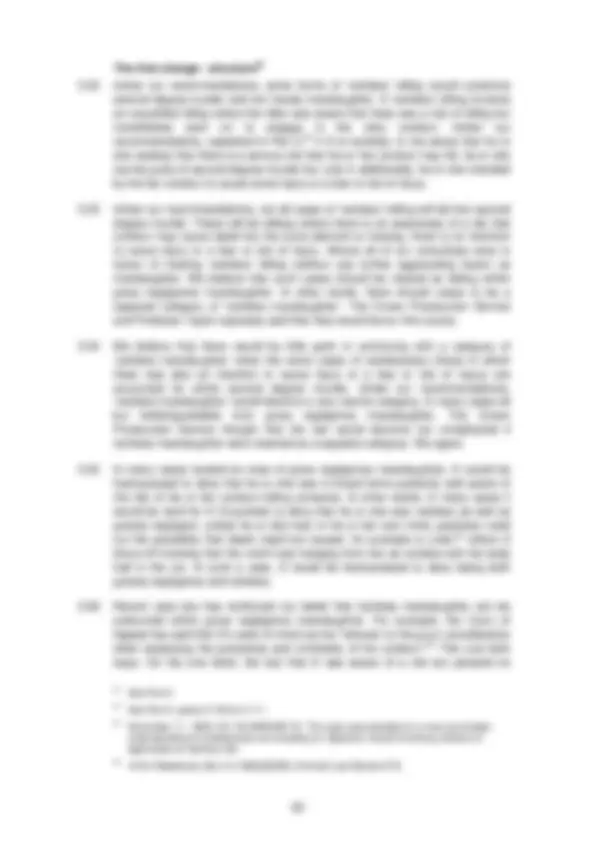
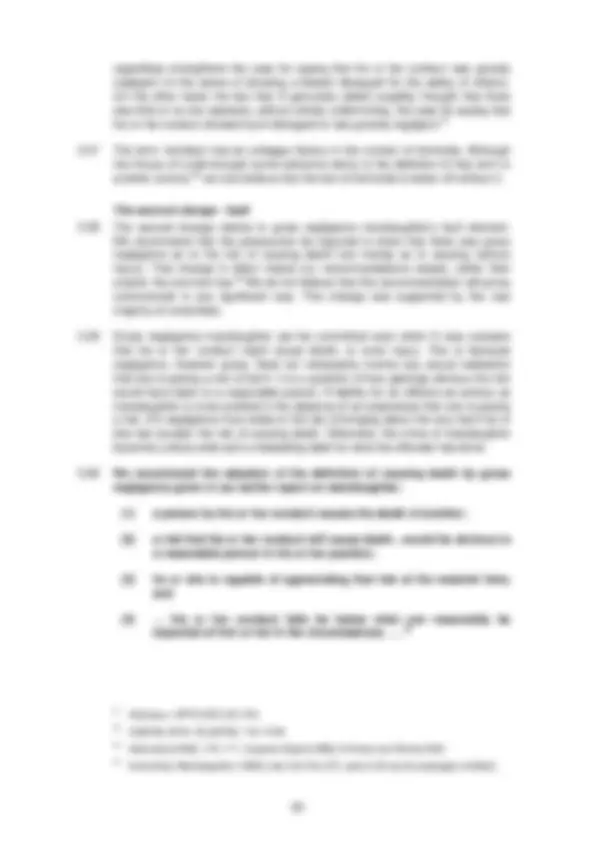
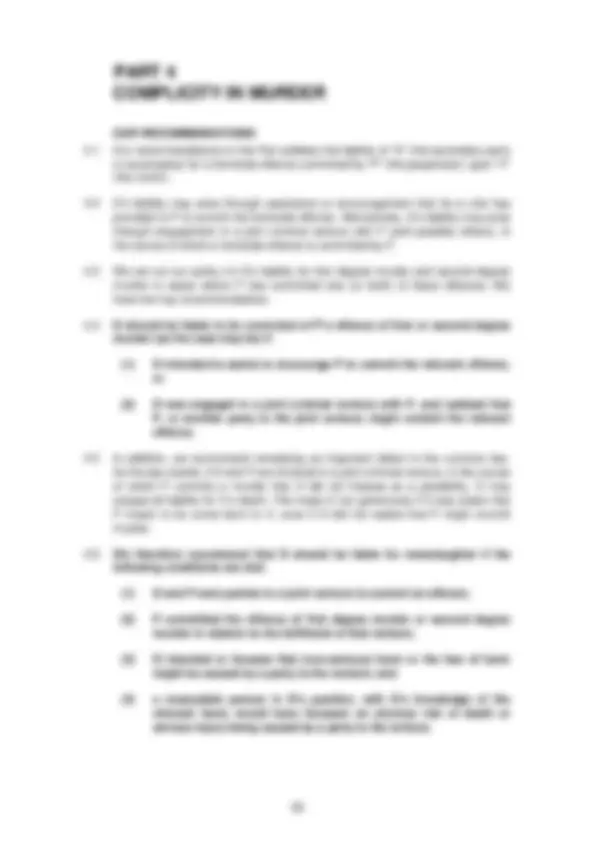
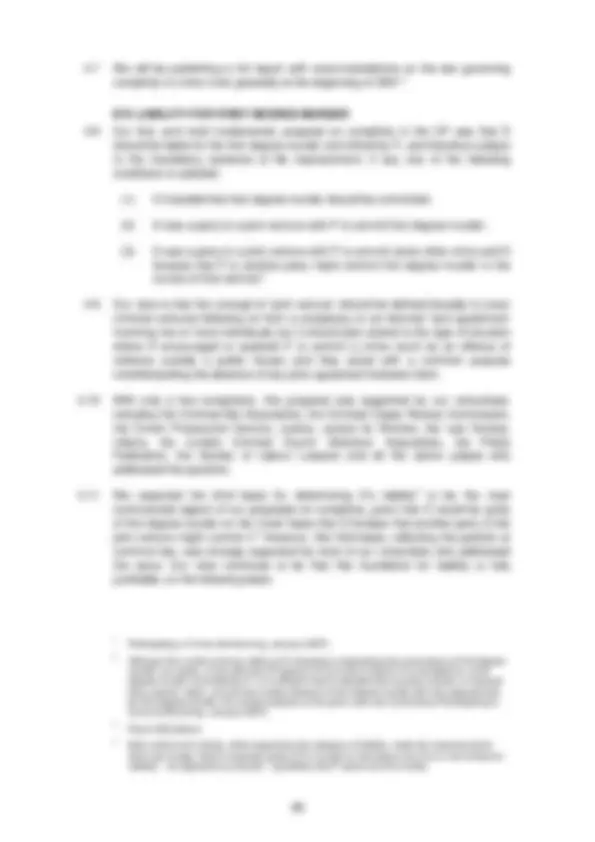
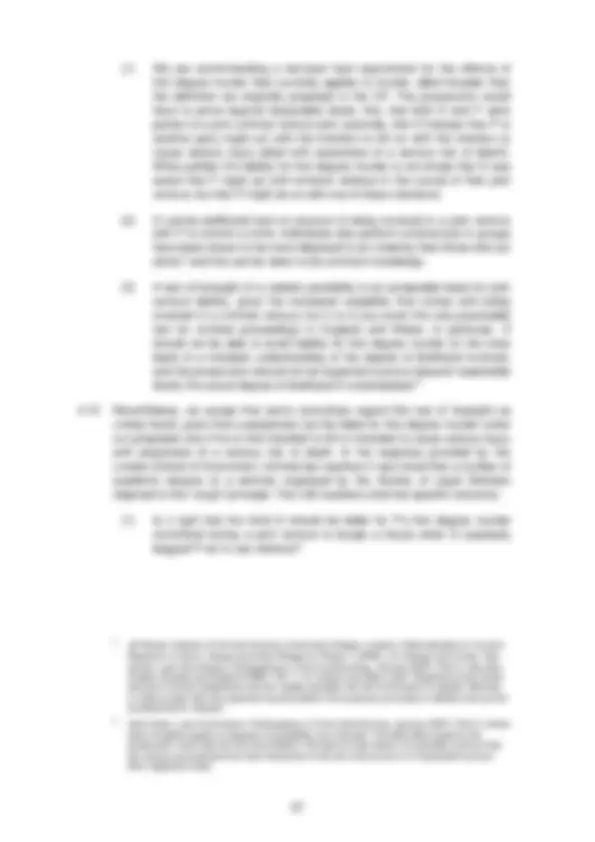
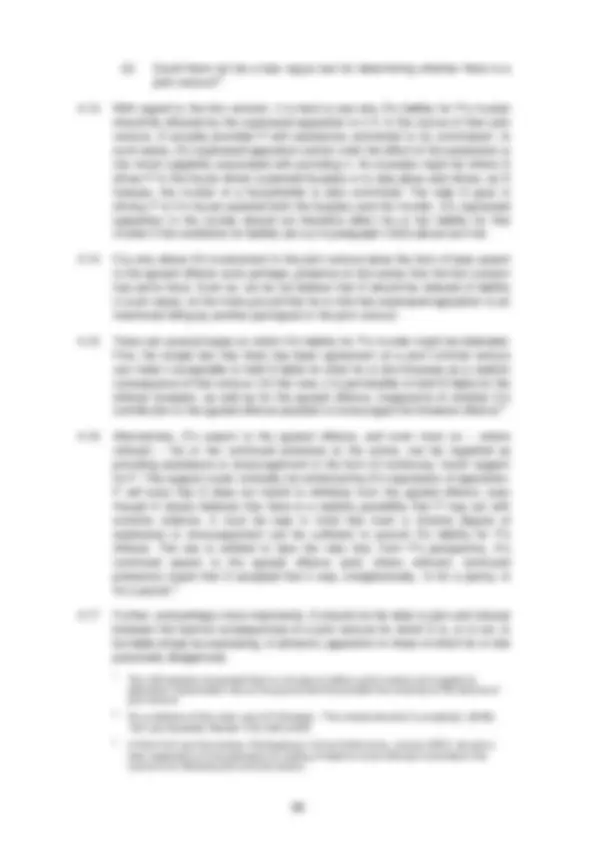
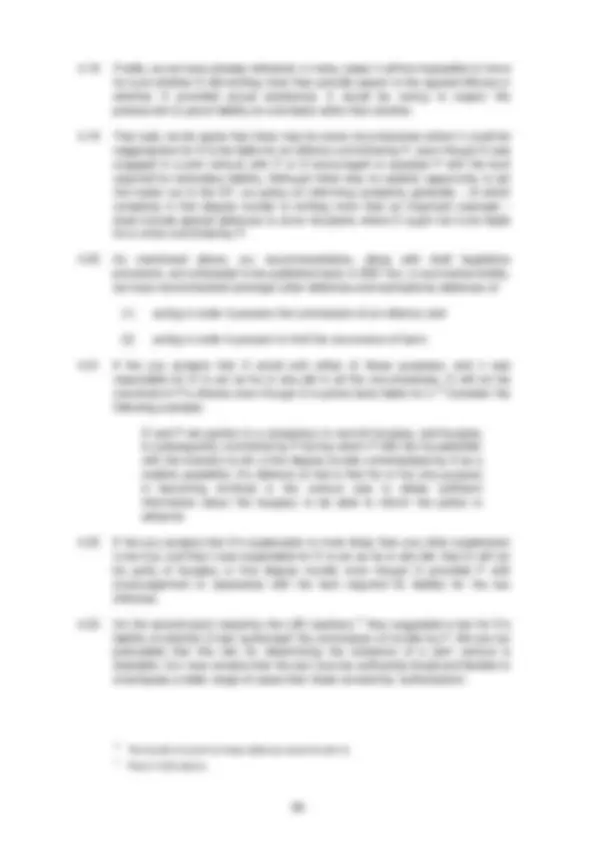
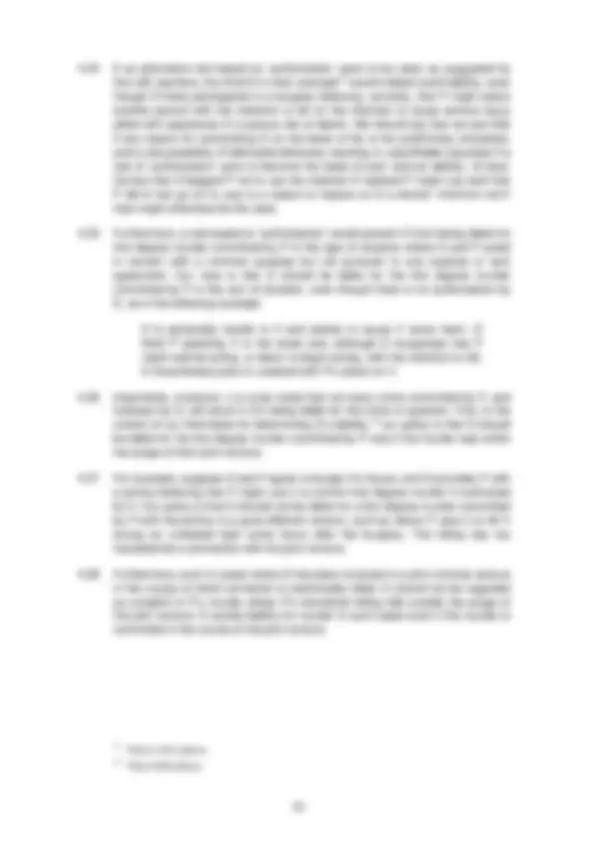
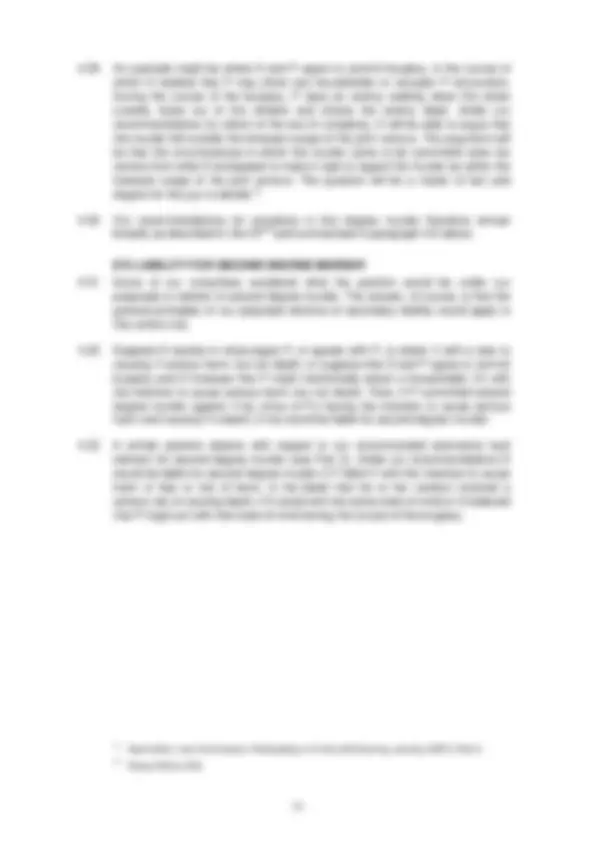
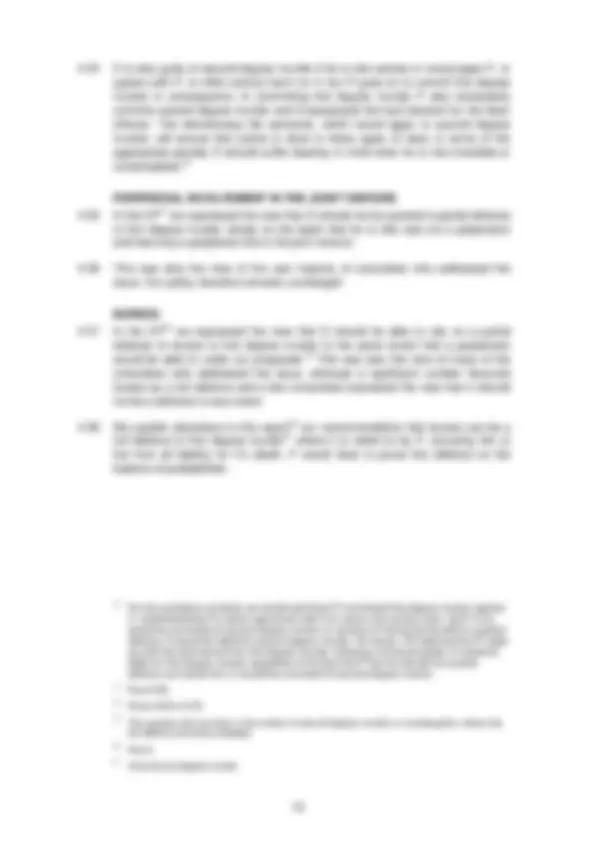
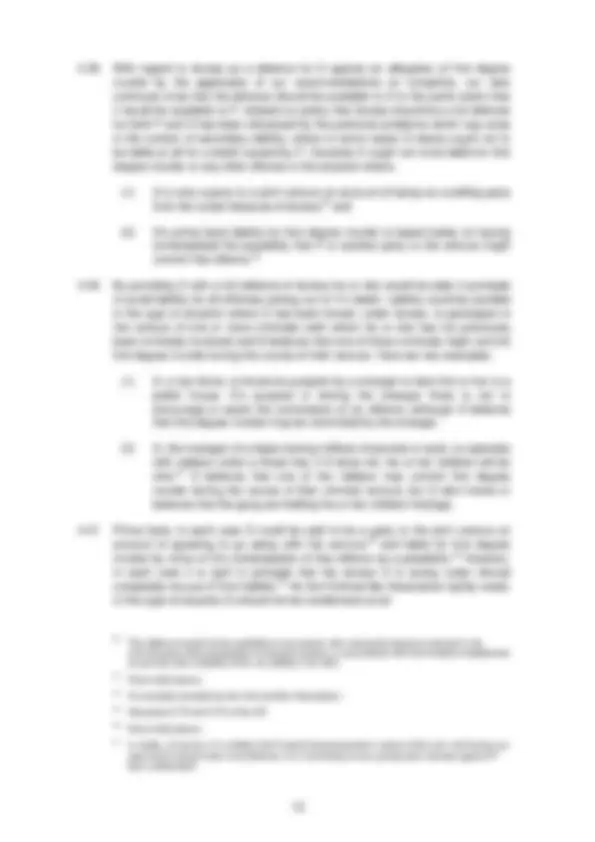
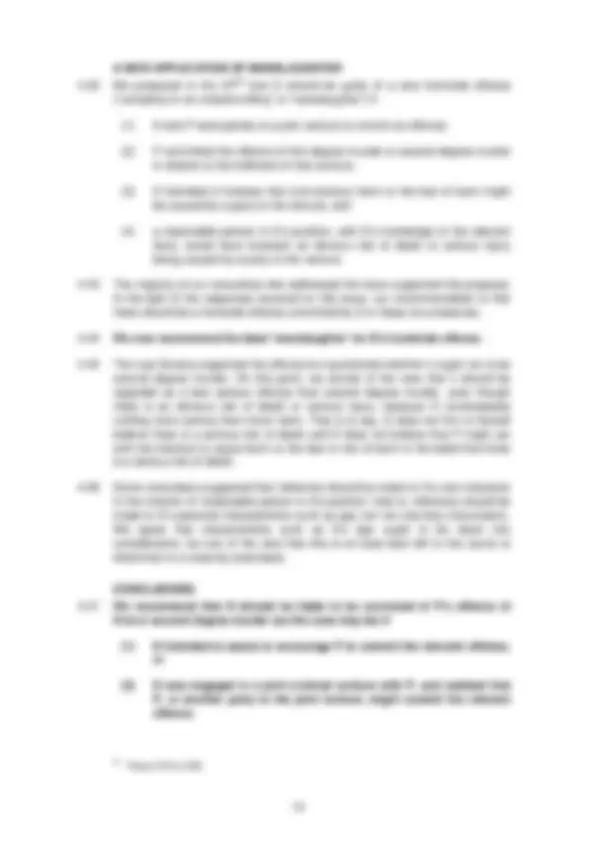

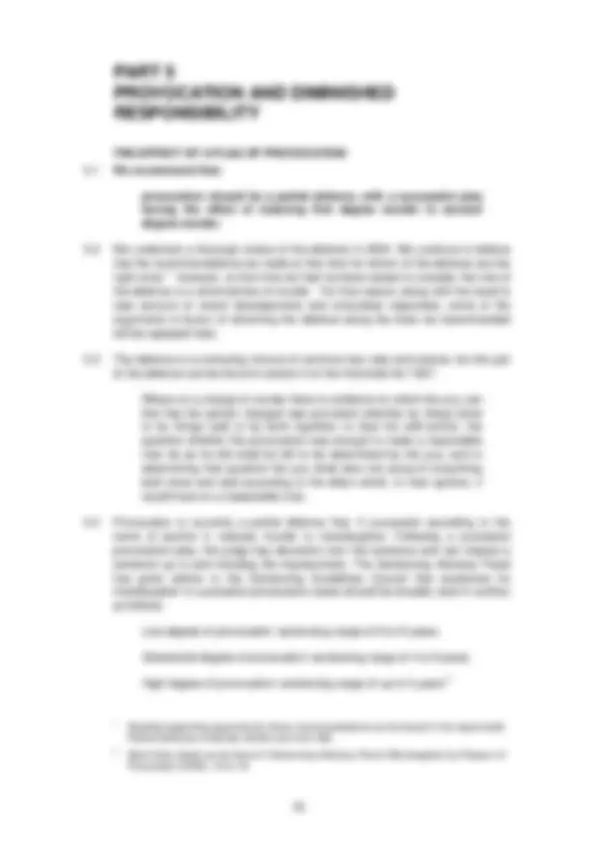
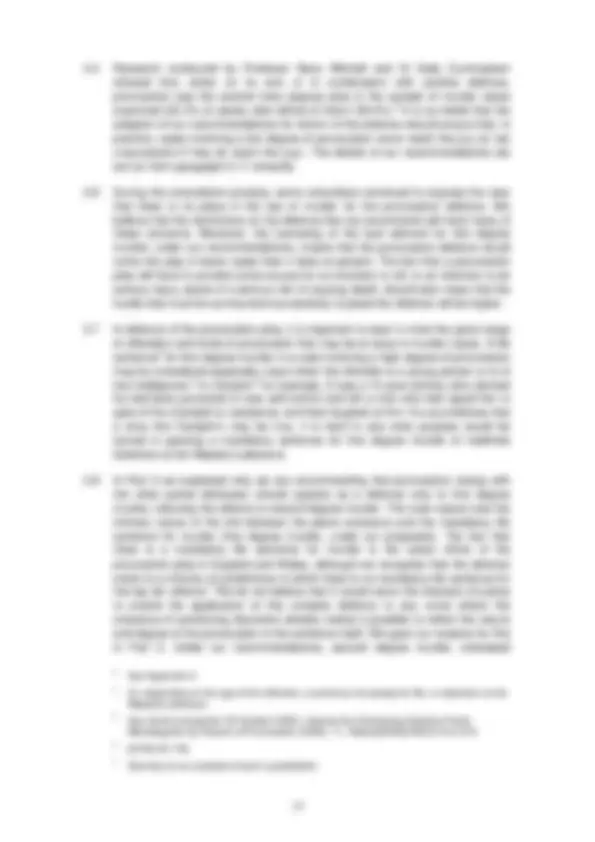
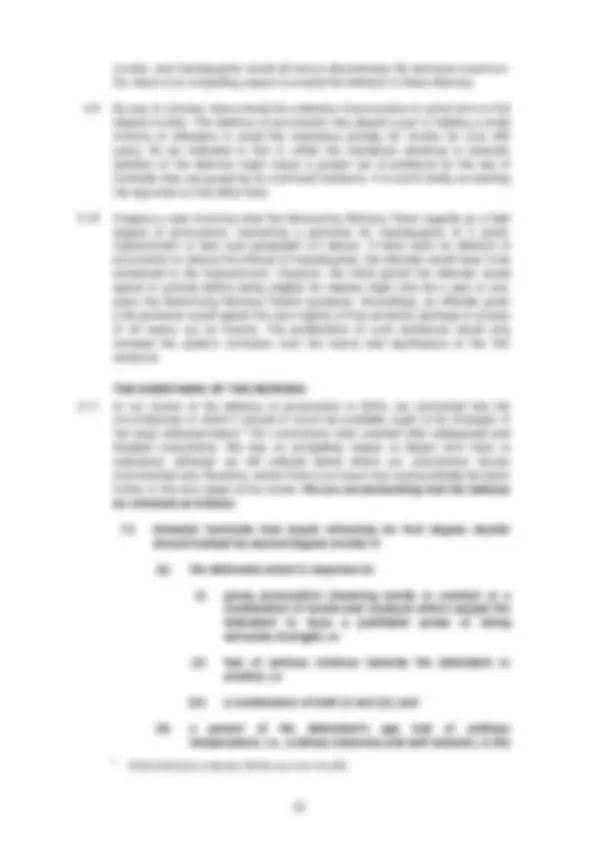
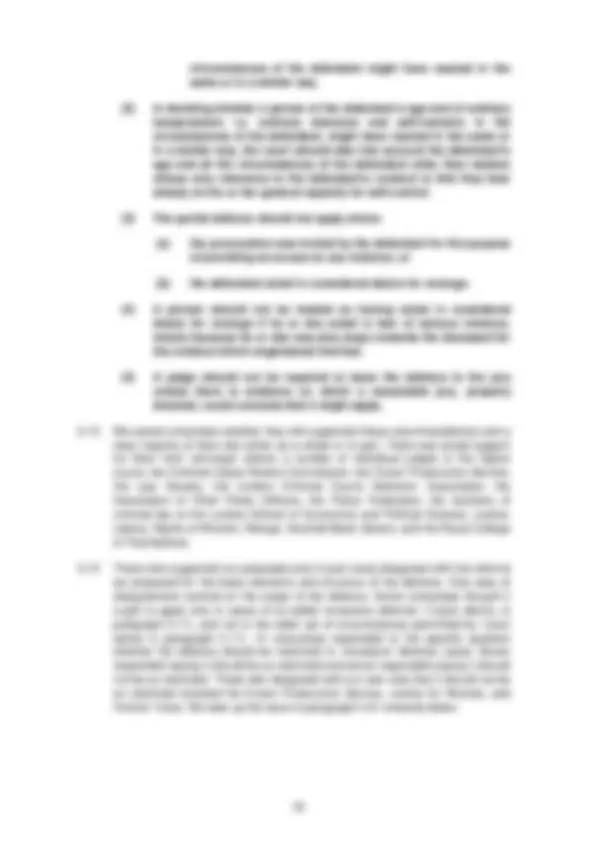
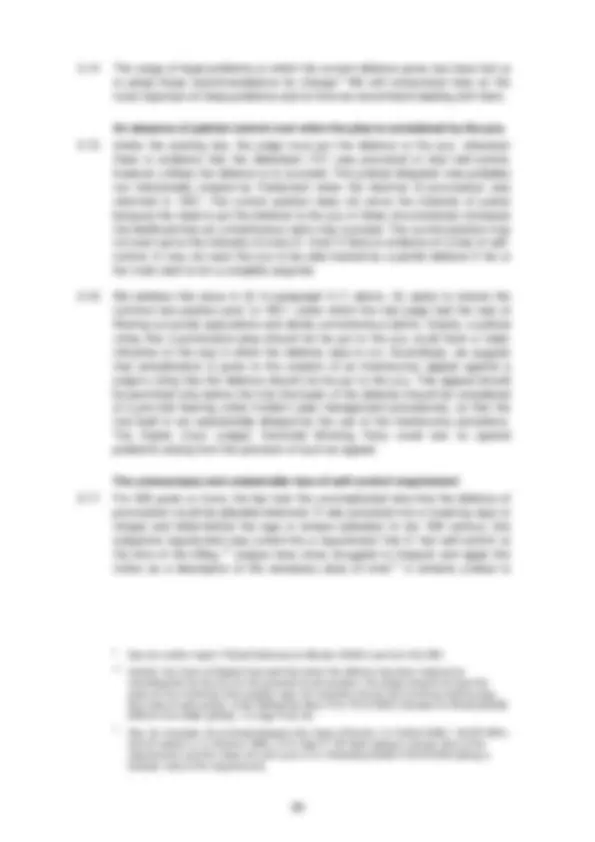
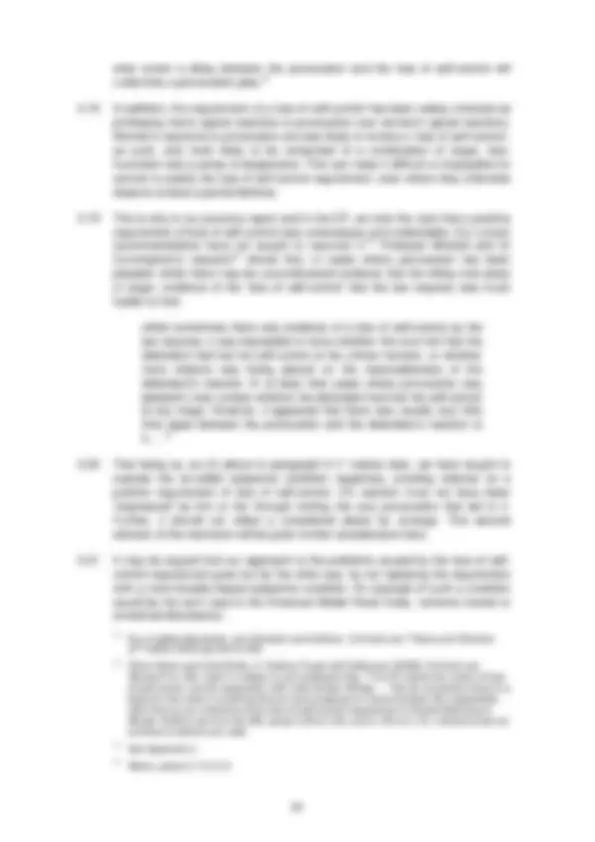
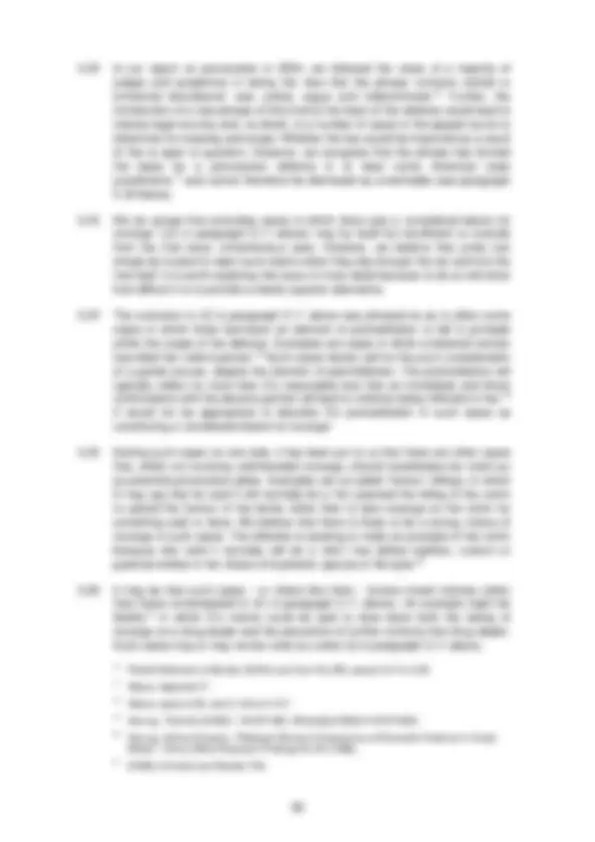

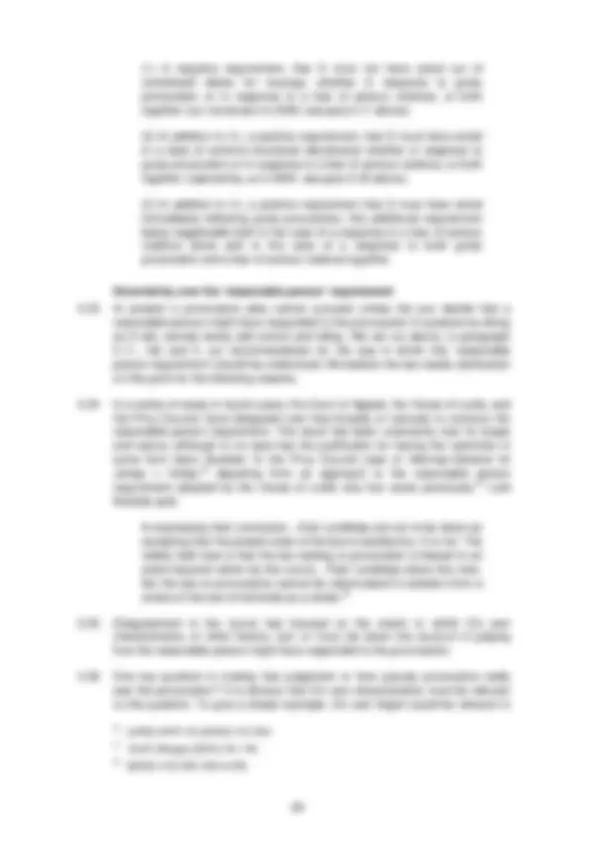
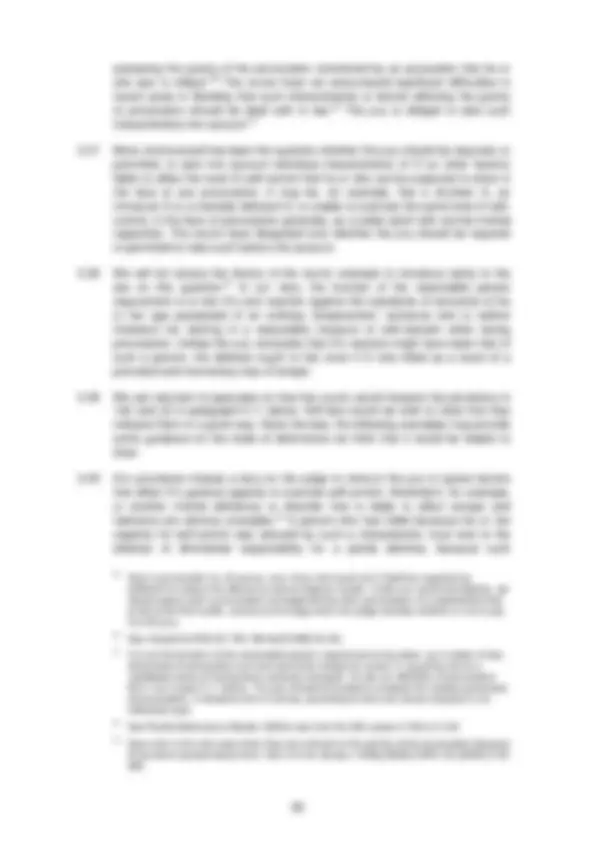
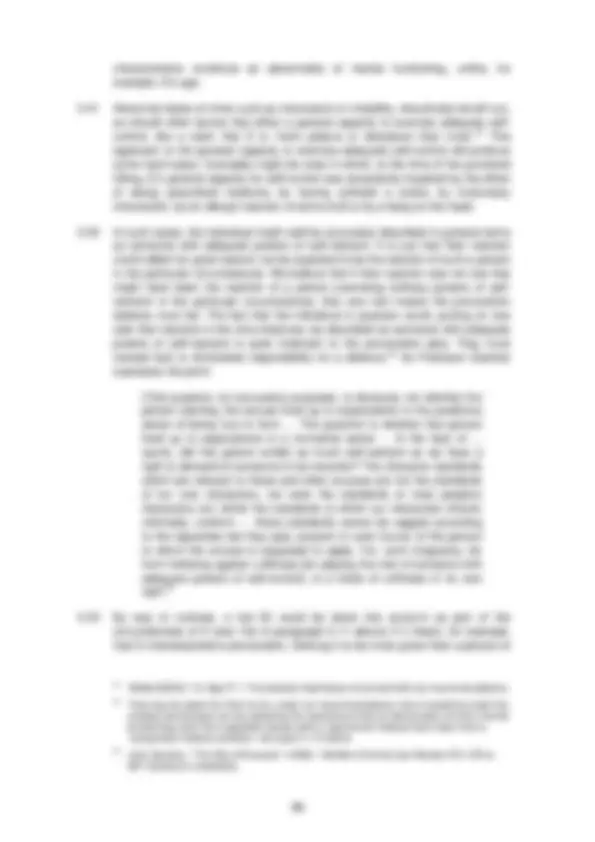
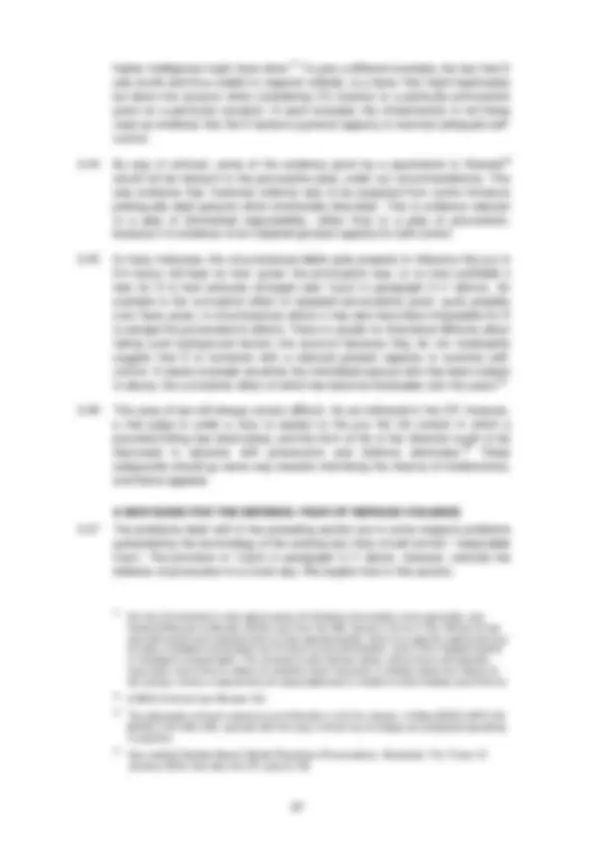
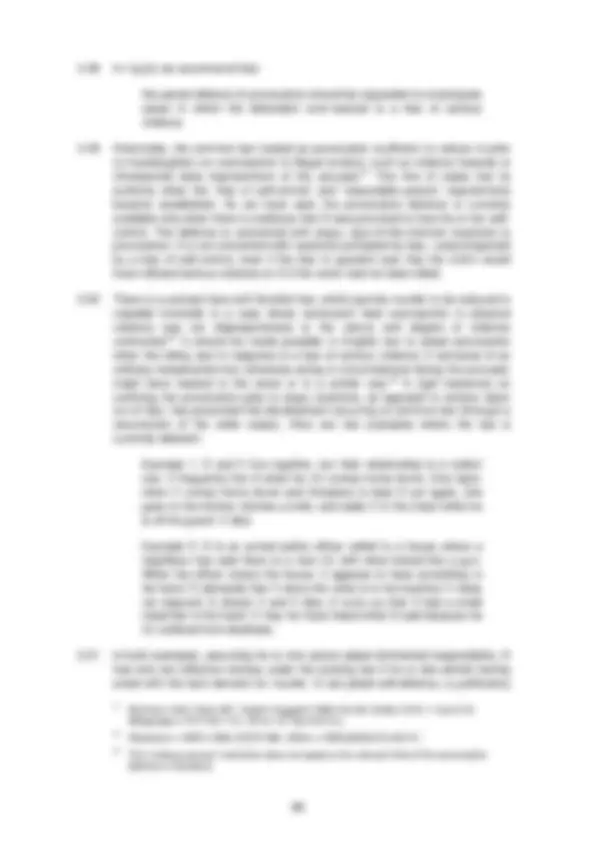
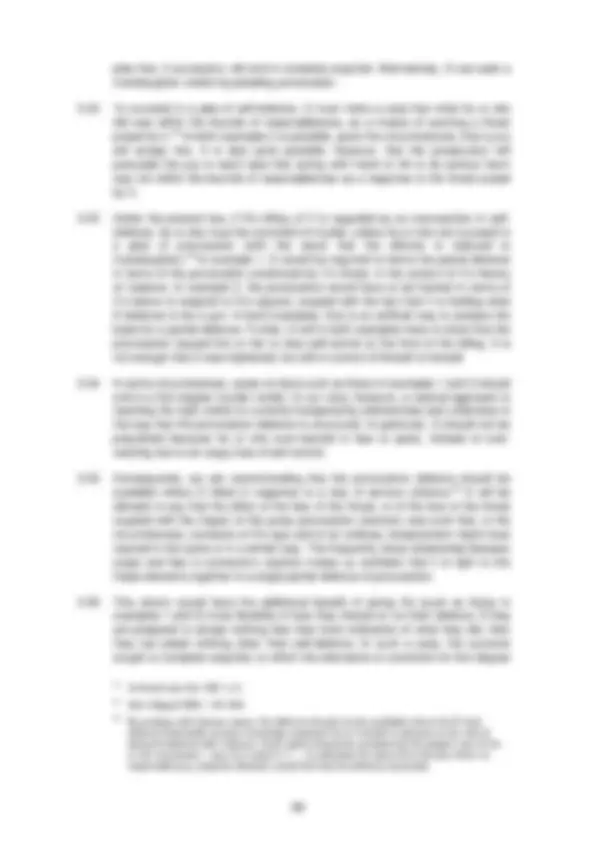
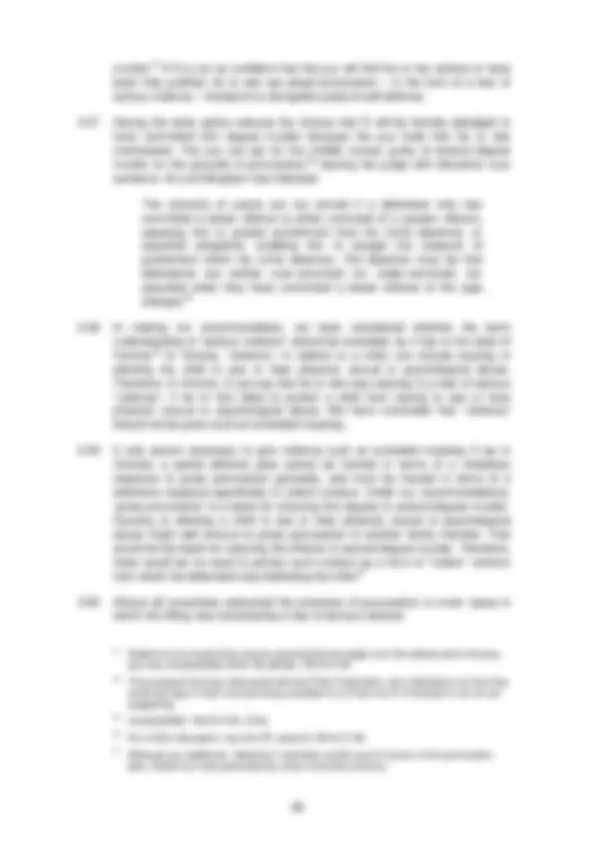


Study with the several resources on Docsity

Earn points by helping other students or get them with a premium plan


Prepare for your exams
Study with the several resources on Docsity

Earn points to download
Earn points by helping other students or get them with a premium plan
Community
Ask the community for help and clear up your study doubts
Discover the best universities in your country according to Docsity users
Free resources
Download our free guides on studying techniques, anxiety management strategies, and thesis advice from Docsity tutors
Why killing through an intention to cause injury or fear or risk of injury while aware of a serious risk of causing death should be second degree murder.
Typology: Slides
1 / 275

This page cannot be seen from the preview
Don't miss anything!





























































































Project 6 of the Ninth Programme of Law Reform: Homicide
Laid before Parliament by the Secretary of State for
Constitutional Affairs and Lord Chancellor pursuant to
section 3(2) of the Law Commissions Act 1965
ii
The Law Commission was set up by the Law Commissions Act 1965 for the purpose of promoting the reform of the law.
The Law Commissioners are:
The Honourable Mr Justice Etherton, Chairman Professor Hugh Beale QC, FBA Mr Stuart Bridge Professor Jeremy Horder Mr Kenneth Parker QC
The Chief Executive of the Law Commission is Mr Steve Humphreys.
The Law Commission is located at Conquest House, 37-38 John Street, Theobalds Road, London WC1N 2BQ.
The terms of this report were agreed on 1 November 2006.
The text of this report is available on the Internet at:
http://www.lawcom.gov.uk
iv
Paragraph Page
PART 2: STRUCTURE WITHIN THE LAW OF HOMICIDE 2.1 19
A three-tier structure 2.1 19
Why a further tier is necessary 2.3 19 Approaches for reform that we reject 2.8 20 Retaining a two-tier scheme but re-aligning murder and manslaughter
Restricting murder to intentional killing 2.10 20 Expanding murder to include all killings where there was an intention to cause some harm
Defining murder to include killing where the defendant is ‘reckless’ as to causing death
A single homicide offence 2.18 22 The approach that we recommend 2.23 22 A three-tier structure 2.23 22 An alternative three-tier scheme including an ‘aggravated’ offence of murder
Offence labels 2.36 25
How sharply do offences need to be distinguished? 2.45 26
First degree murder 2.50 28
The provisional proposals in the CP 2.51 28 Responses to the provisional proposal 2.53 28 The impact of the responses on our thinking: a wider definition of first degree murder
The advantages of our recommendation compared to our provisional proposal
How our recommendation would be an improvement on the existing law
Second degree murder 2.70 32
The different functions that second degree murder would perform
Why killing through an intention to do serious injury (but without awareness that there was a risk of causing death) should be treated as second degree murder
The meaning of ‘injury’ 2.82 34 Should ‘serious’ injury be defined? 2.86 35 Approach 1: defining ‘serious’ injury 2.88 35 Approach 2: not defining ‘serious’ injury 2.93 36
v
Paragraph Page Why killing through an intention to cause injury or fear or risk of injury while aware of a serious risk of causing death should be second degree murder
Introduction 2.95 37 The provisional proposal in the CP 2.99 38 Responses to the provisional proposal 2.100 38 A new formulation 2.105 39 Advantages of the new formula 2.108 40 Resurrecting the ‘felony-murder’ approach? 2.112 41 Conclusion 2.115 41
The three-tier structure and ‘split’ juries 2.117 42
Partial defences 2.122 43
Introduction 2.122 43 The provisional proposals in the CP 2.124 43 Responses to our proposals 2.125 43 Should the law of homicide retain partial defences? 2.130 44 Should each partial defence have the same effect? 2.132 44 The problem of ‘split’ juries 2.132 44 Should the operation of partial defences be confined to first degree murder?
Should a successful partial defence plea to first degree murder result in a verdict of second degree murder or manslaughter?
Conclusion 2.158 50
Manslaughter 2.159 50
Introduction 2.159 50 The scope of manslaughter within the three-tier structure 2.163 51
Should killing a police officer on duty be first degree murder even if the killer did not have the fault element for first degree murder?
Introduction 3.1 53
How different fault elements fit the new structure 3.1 53 The different fault elements and the ‘ladder’ approach 3.4 53
vii
Paragraph Page
Diminished responsibility and insanity 5.138 108
Introduction 6.1 111
The current law 6.5 112
Our provisional proposals and questions 6.12 114 Responses to the provisional proposals and questions 6.17 115
Our recommendations 6.21 116
Options we reject 6.22 116
Option (2): duress should be a partial defence to first degree murder resulting in a conviction for second degree murder but a full defence to second degree murder and attempted murder
Option (3): duress should be a partial defence to first degree murder resulting in a conviction for second degree murder and a partial defence to second degree murder resulting in a conviction for manslaughter
Option (4): duress should be a partial defence to both first degree murder and second degree murder, in each case resulting in a conviction for manslaughter
Option (5): duress should be a partial defence to first degree murder but not a defence to second degree murder or attempted murder
The option that we are recommending 6.36 119
Option (1): duress should be a full defence to first degree murder, second degree murder and attempted murder
A full defence to first degree murder 6.36 119 Reasons for questioning our provisional proposal that duress should be a partial defence to first degree murder
Reasons for concluding that duress should be a full defence to first degree murder
Distinguishing cases according to whether or not the defendant acted in response to a threat against his or her own person
Distinguishing between principal offenders and secondary parties
Consistency with provocation and diminished responsibility
viii
Paragraph Page A possible refinement of our recommendation 6.66 126 A full defence to second degree murder and attempted murder
Additional recommendations 6.73 127
Fear of death or life-threatening harm 6.73 127 Reasonably held belief 6.77 128 The defendant’s characteristics for the purpose of the objective limb of the defence
A reverse burden of proof 6.87 130 A further consultation 6.87 130 The further questions that we asked 6.88 130 The responses 6.92 131 The objective limb of the defence 6.95 131 Burden of proof and defences 6.97 132 Reasons for departing from the common law principle 6.101 133 The problem of disproving duress 6.101 133 No analogy with provocation and self- defence
Duress emanating from or relating to acts outside the jurisdiction
Collaboration between criminals 6.109 135 Distinguishing murder and attempted murder from other offences
Article 2 of the ECHR 6.112 135 Conclusion 6.115 137 Compatibility with Article 6(2) of the ECHR 6.116 137 The Strasbourg jurisprudence 6.117 137 The House of Lords’ cases 6.118 138 Is there an interference? 6.120 138 Is there a legitimate aim? 6.123 139 Is the interference proportionate? 6.124 139 The seriousness of the offence and the severity of the penalty
The extent and nature of the factual matters required to be proved by the accused, and their importance relative to the matters required to be proved by the prosecution
x
Paragraph Page
Current law 8.6 157
History and previous reform proposals 8.13 158
Consultation and recent research 8.15 159
Provisional proposal 8.15 159 Consultation responses 8.16 159 Recent research 8.20 160
Substantive law: recommendation and reasons 8.23 161
Recommendation 8.23 161 Psychiatric foundation 8.24 161 Limitation to biological mothers 8.27 162 Age limit 8.32 163 Merger with diminished responsibility 8.35 164 Causation 8.40 166 Application to first degree murder and second degree murder 8.42 166
Procedural issue: recommendation and reasons 8.44 167
The Kai-Whitewind dilemma 8.44 167 Provisional proposal 8.46 167 Consultation 8.50 169 Recommendation and reasons 8.57 171
THE LAW COMMISSION
MURDER, MANSLAUGHTER AND INFANTICIDE To the Right Honourable the Lord Falconer of Thoroton, Secretary of State for Constitutional Affairs and Lord Chancellor
PART 1 WHY IS A NEW HOMICIDE ACT NEEDED?
1.1 In July 2005, the Government announced a review of the law of murder in England and Wales, with the following terms of reference:
(1) To review the various elements of murder, including the defences and partial defences to it, and the relationship between the law of murder and the law relating to homicide (in particular manslaughter). The review will make recommendations that:
(a) take account of the continuing existence of the mandatory life sentence for murder;
(b) provide coherent and clear offences which protect individuals and society;
(c) enable those convicted to be appropriately punished; and
(d) are fair and non-discriminatory in accordance with the European Convention of Human Rights and the Human Rights Act 1998.
(2) The process used will be open, inclusive and evidence-based and will involve:
(a) a review structure that will look to include key stakeholders;
(b) consultation with the public, criminal justice practitioners, academics, those who work with victims’ families, parliamentarians, faith groups; and
(c) looking at evidence from research and from the experiences of other countries in reforming their law.
(3) The review structure will include consideration of areas such as culpability, intention, secondary participation etc inasmuch as they apply to murder. The review will only consider the areas of euthanasia and suicide inasmuch as they form part of the law of murder, not the more fundamental issues involved which would need separate debate. For the same reason abortion will not be part of the review.
1.7 The third issue is the fact that there is no draft Homicide Bill reflecting our recommendations. The Law Commission commonly appends a draft Bill to accompany its reports but we have not done so in this report. This is because our report is only the first stage in the current review of the law of homicide. The Home Office will be undertaking the second stage of the review. 4 Accordingly, it would have been inappropriate for the Commission to produce a draft Bill.
1.8 The law governing homicide in England and Wales is a rickety structure set upon shaky foundations. Some of its rules have remained unaltered since the seventeenth century, even though it has long been acknowledged that they are in dire need of reform. Other rules are of uncertain content, often because they have been constantly changed to the point that they can no longer be stated with any certainty or clarity. At the end of the nineteenth century there was a valuable attempt at wholesale reform. This was thwarted largely by quite unconnected political problems. The consequence was that the Homicide Bill did not progress beyond its second reading in Parliament. Moreover, certain piecemeal reforms effected by Parliament, although valuable at the time, are now beginning to show their age or have been overtaken by other legal changes and, yet, have been left unreformed.^5
1.9 This state of affairs should not continue. The sentencing guidelines that Parliament has recently issued for murder cases^6 presuppose that murder has a rational structure that properly reflects degrees of fault and provides appropriate defences. Unfortunately, the law does not have, and never has had, such a structure. Putting that right is an essential task for criminal law reform.
1.10 We will recommend that, for the first time, the general law of homicide be rationalised through legislation. Offences and defences specific to murder must take their place within a readily comprehensible and fair legal structure. This structure must be set out with clarity, in a way that will promote certainty and in a way that non-lawyers can understand and accept.
1.11 We will be going into these matters in much greater depth but the following is a brief explanation of the existing law and its flaws.
The current structure of offences
1.12 Two general homicide offences – murder and manslaughter – cover the ways in which someone might be at fault in killing. There are also a number of specific homicide offences, for example, infanticide and causing death by dangerous driving (the latter was not within our terms of reference for consideration).
1.13 Murder, which carries a mandatory life sentence, is committed when someone (“D”) unlawfully kills another person (“V”) with an intention either to kill V or to do V serious harm. (^4) This second stage will involve a public consultation on the broader areas of public policy which any review of the law of homicide needs to address. (^5) Some of the historical background on attempts to reform the law of murder is given in Part 1 of the CP. (^6) Criminal Justice Act 2003, s 269 and sch 21.
1.14 Manslaughter can be committed in one of four ways:
(1) killing by conduct that D knew involved a risk of killing or causing serious harm (‘reckless manslaughter’);
(2) killing by conduct that was grossly negligent given the risk of killing (‘gross negligence manslaughter’);^7
(3) killing by conduct taking the form of an unlawful act involving a danger of some harm to the person (‘unlawful act manslaughter’); or
(4) killing with the intent for murder but where a partial defence applies, namely provocation, diminished responsibility or killing pursuant to a suicide pact.
The term ‘involuntary manslaughter’ is commonly used to describe a manslaughter falling within (1) to (3) while (4) is referred to as ‘voluntary manslaughter’.
Problems with these offences
1.15 The current definitions of these offences (and, for the most part, of the provocation defence) are largely the product of judicial law making in individual cases over hundreds of years. They are not the products of legislation enacted after wide consultation and research into alternative possibilities. From time to time, the courts have tinkered with the definitions. New cases have then generated further case law to resolve ambiguities or new avenues for argument left behind by the last case.^8
1.16 We identified a number of problems with the homicide offences in the CP. The consultation process has confirmed that numerous problems exist.
The serious harm rule
1.17 Under the current law, D is liable for murder not only if he or she kills intentionally but also if he or she kills while intentionally inflicting harm which the jury considers to have been serious. In our view, the result is that the offence of murder is too wide. Even someone who reasonably believed that no one would be killed by their conduct and that the harm they were intentionally inflicting was not serious, can find themselves placed in the same offence category as the contract or serial killer. Here is an example:
D intentionally punches V in the face. The punch breaks V’s nose and causes V to fall to the ground. In falling, V hits his or her head on the curb causing a massive and fatal brain haemorrhage.
(^7) It is sometimes argued that manslaughter by recklessness and by gross negligence form one single category of manslaughter with two alternative fault requirements. We will be recommending that any reform of the law should adopt this approach: see Part 3. (^8) Eg, on murder see Woollin [1999] 1 AC 82 and on manslaughter see Adomako [1995] 1 AC 171 and Smith (Morgan) [2001] 1 AC 146.
1.22 Having said that, we do not recommend that killing through an intention to do serious injury^16 should simply be regarded as manslaughter. Manslaughter is an inadequate label for a killing committed with that degree of culpability. In any event, to expand the law of manslaughter still further would be wrong because manslaughter is already an over-broad offence.^17
1.23 We will be recommending that the intent-to-do-serious-injury cases should be divided into two. Cases where D not only intended to do serious injury but also was aware that his or her conduct posed a serious risk of death should continue to fall within the highest category or top tier offence. This is warranted by the kind of total disregard for human life that such Ds show. They are morally equivalent to cases of intentional killing. Cases where D intended to do serious injury but was unaware of a serious risk of killing should fall (along with some instances of reckless killing) into a new middle tier homicide offence.
Reckless manslaughter
1.24 The scope of murder is both too broad and too narrow. Where the scope of murder is too narrow, the scope of manslaughter is correspondingly too broad. In particular, the law is too generous to some who kill by ‘reckless’ conduct, that is those who do not intend to cause serious harm but do realise that their conduct involves an unjustified risk of causing death. The law is too generous in treating all those who realise that their conduct poses a risk of causing death but press on regardless as guilty only of manslaughter. Again, the problems have arisen from the way that periodic judicial development of the law in individual cases, albeit well-intentioned, has changed the boundaries of homicide offences.
1.25 It is necessary to provide some brief background to the discussion. When the Homicide Act 1957 was passed, it was still accepted by both Parliament and by the courts that the archaic language of ‘malice aforethought’ governed the fault element in murder. But malice aforethought has never been a term with very clear boundaries and differences soon emerged between the courts and Parliament over how it should be understood (as indicated in paragraph 1. above).
(^16) We are recommending use of the term ‘injury’ in place of ‘harm’: see Part 2. (^17) The need to narrow the crime of involuntary manslaughter has already been accepted by Government: Home Office, Reforming the Law on Involuntary Manslaughter: The Government’s Proposals (2000).
1.26 At that time, the courts treated malice aforethought as covering cases in which the offender: either (a) intended to kill; or (b) intended to cause serious harm; or (c) had knowledge that the act which causes death will probably cause the death of or grievous bodily harm to some person.^18 However, during the passage of the Homicide Act 1957, Parliament was led to believe that (b) was not a species of malice aforethought and that malice aforethought could not be established without D being proven to have at least been aware that the harm done was life- threatening. This was the basis upon which the Homicide Act 1957 was passed. Parliament’s belief was founded on the Lord Chief Justice’s evidence to the Royal Commission on Capital Punishment, whose report led to the passing of the Homicide Act 1957.^19
1.27 Defined either way, however, malice aforethought provided sufficient coverage to ensure that the worst kinds of reckless killer could be convicted of murder. Here is an example:
D, intending to cause fear and disruption, plants a bomb. D gives a warning which D believes might be sufficient to permit the timely evacuation of the area but probably would not be. In the ensuing explosion, someone is killed.
1.28 At the time of the enactment of the Homicide Act 1957, such a person would have been regarded by both Parliament and the courts as acting with ‘malice aforethought’ and would be guilty of murder. As Lord Chief Justice Cockburn, many years before, had put it:
If a man did an act, more especially if that were an illegal act, although its immediate purpose might not be to take life, yet if it were such that life was necessarily endangered by it, - if a man did such an act, not with the purpose of taking life, but with the knowledge or belief that life was likely to be sacrificed by it, that was not only murder by the law of England, but by the law of probably every other country.^20
(^18) Sir James Stephen, Digest of the Criminal Law (1877), Art 223(b). (^19) See the CP, paras 1.119 to 1.121. (^20) Desmond , The Times , April 28, 1868. So far as other countries are concerned, Lord Cockburn CJ was guilty of a little exaggeration. In France an intention to kill was required at that time (and it still is) if the offender was to be guilty of the most serious homicide offence: Sir James Stephen , History of the Criminal Law of England (1883), vol III, 90 to
The ‘two category’ structure of general homicide offences
1.32 The distinction between murder and manslaughter is almost certainly over 500 years old. No further general category of homicide has been developed over the intervening period. So, over the centuries, the two categories of murder and manslaughter have had to bear the strain of accommodating changing and deepening understandings of the nature and degree of criminal fault and the emergence of new partial defences. They have also had to satisfy demands that labelling and sentencing should be based on rational and just principles.
1.33 Further, the existence of the death penalty and, then, its successor the mandatory life sentence for murderers, has meant that the argument over who should be labelled a ‘murderer’ has become identified with who should receive the mandatory sentence for murder. Whilst in some respects understandable, the link with sentencing can distort the argument about labels. For example, it is arguable, and we will recommend that, although a person who kills intentionally in response to gross provocation does not deserve a mandatory sentence, he or she should still be labelled a ‘murderer’.
1.34 Our consultees almost all agreed that the two-category structure of the general law of homicide is no longer fit for purpose. Consequently, we are proposing to replace the two-tier structure with a three-tier structure. Such a structure will be much better equipped to deal with the stresses and strains on the law and with the issues of appropriate labelling and sentencing. The three tiers in descending order of seriousness would be first degree murder, second degree murder and manslaughter.
1.35 Under our recommendations, first degree murder would encompass:
(1) intentional killing; or
(2) killing through an intention to do serious injury with an awareness of a serious risk of causing death.
1.36 Second degree murder would encompass:
(1) killing through an intention to do serious injury (even without an awareness of a serious risk of causing death); or
(2) killing where there was an awareness of a serious risk of causing death, coupled with an intention to cause either:
(a) some injury;
(b) a fear of injury; or
(c) a risk of injury.
1.37 Second degree murder would also be the result when a partial defence of provocation, diminished responsibility or killing pursuant to a suicide pact is successfully pleaded to first degree murder.
1.38 Manslaughter would encompass:
(1) where death was caused by a criminal act intended to cause injury, or where the offender was aware that the criminal act involved a serious risk of causing injury; or
(2) where there was gross negligence as to causing death.
Our recommendations for manslaughter build upon previous Law Commission recommendations and Home Office proposals. 28
Complicity in murder committed by another person
1.39 A serious problem has arisen in murder cases with regard to what lawyers call the doctrine of ‘complicity’, that is, involving oneself in a criminal enterprise with another who commits murder. A typical example might be where A, B and C see V (a supporter of a rival football team), walking home alone. They set upon V punching and kicking him. When V falls over, B produces a knife and stabs V through the heart. A and C say that (i) although they knew that B sometimes carried a knife, they did not know he would use it on this occasion, and (ii) they did not have murder in mind when attacking V.
1.40 In this example, B is likely to be found guilty of murder as a principal offender. The question is: are A and C involved in the killing in some way that is sufficiently culpable to warrant being guilty of a homicide offence? The law currently answers this question by telling the jury to ask itself whether there was a ‘fundamental difference’ between what A and C thought might happen and what B did. 29 If the jury thinks that there was such a fundamental difference, then A and C are guilty of no homicide offence at all. A and C will be guilty of assaulting V, but assault is obviously a much lesser offence than murder or manslaughter.
1.41 We believe that this represents a gap in the law. It should be possible to convict A and C of a homicide offence. This gap appears especially significant when people in A and C’s position knew from the start of the joint criminal venture that the person who eventually commits the murder was armed. In such circumstances, the mere fact that they did not foresee that the armed participant would actually commit murder should not absolve A and C from all responsibility for the homicide.
1.42 In the CP,^30 we put forward a proposal for filling this gap. It was that A and C should be guilty of manslaughter if:
(1) they were engaged in a joint criminal venture with B; and
(2) it should have been obvious to them that B might commit first or second degree murder in the course of that joint criminal venture.
(^28) Involuntary Manslaughter (1996) Law Com No 237; Home Office, Reforming the Law on Involuntary Manslaughter: The Government’s Proposals (2000). (^29) Powell and Daniels, English [1999] 1 AC 1. (^30) Para 5.83.